
We’ve all heard the stories – the forgotten sports car, the abandoned barn, that truly once-in-a-lifetime find. If you’re anything like me, the thought of stumbling across a [insert your most desirable classic make and model here] in a derelict farm building, is right up there with divvying first division lottery winnings before you’ve even purchased a ticket. Daydreaming is a pleasant way to pass the time for sure, but in reality, the chance of it ever actually happening are remote at best. Despite the odds, amazing finds do happen though, and here’s the proof – a Mazda Savanna RX-3 thought lost for almost 30 years.
Intrigued? You need to read on then…

How this rotary-engined relic ended up in New Zealand via a residential basement garage in California is a bit of a story in itself – and I’ll get to that in a moment. But first you need to know exactly what it is you’re looking at, because this is no street car dressed up to look like a race car, but the absolute real deal from a bygone era of racing.
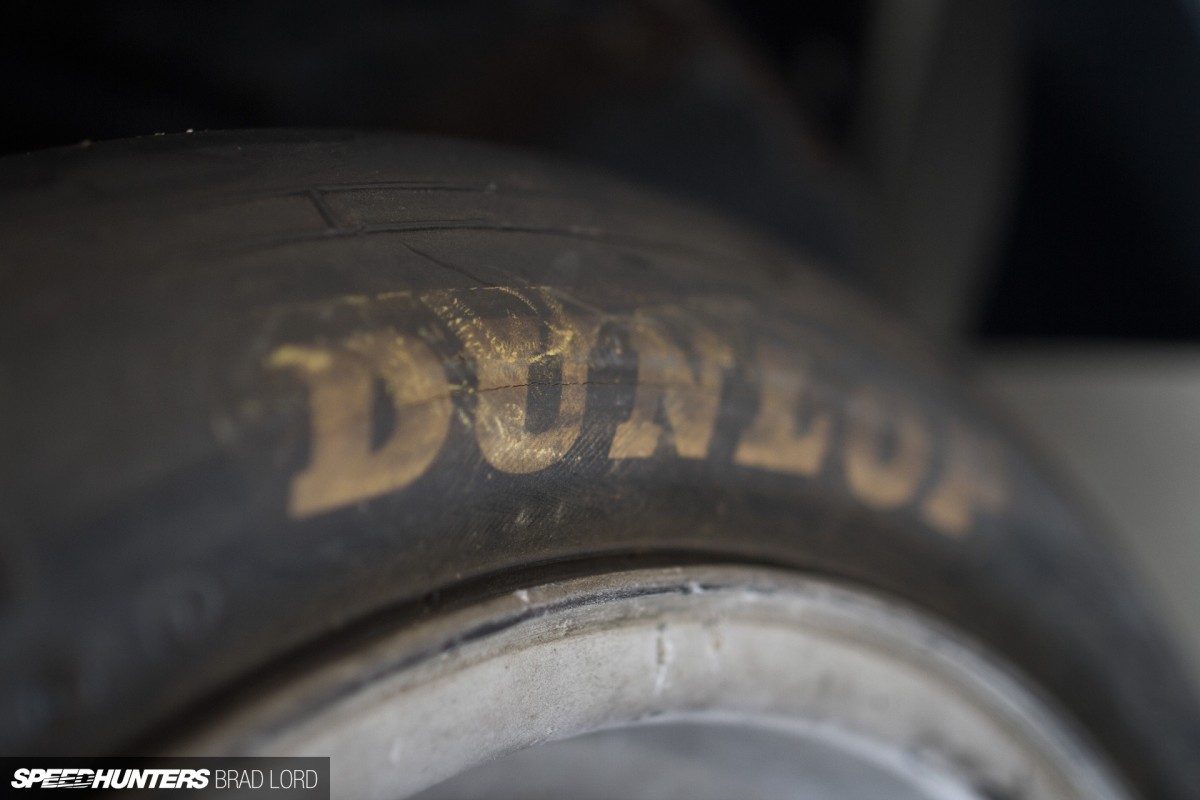
And when I say real, I talking about right down to the smallest details. The cracked and time-hardened Dunlop slicks that grace all four corners of the Mazda are the last tyres it raced on in the late ’70s/early ’80s, before being put into dry storage and all but forgotten about.

Those final door-to-door battles might have been contested in the US on the IMSA circuit, but prior to being exported stateside, the RX-3 had been built for, and raced within the ranks of the prestigious Japanese Touring Car Championship. Yes, the JTCC.
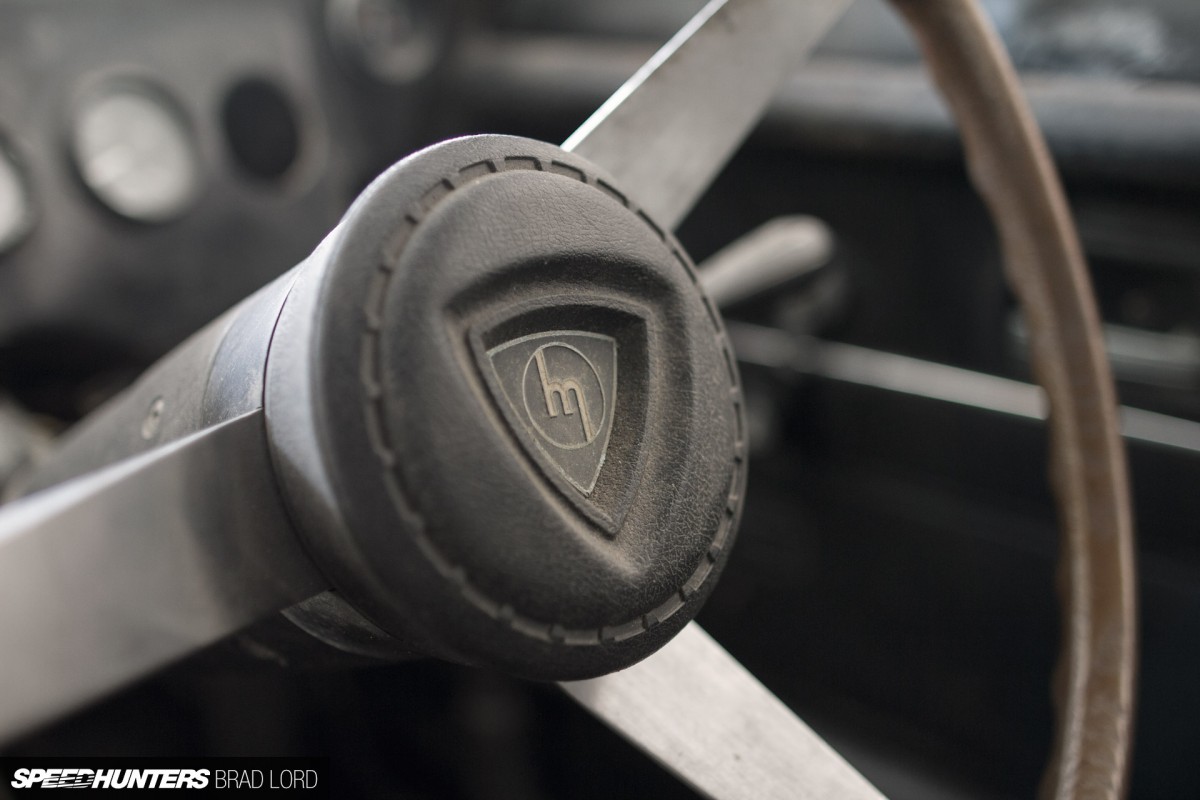
If this car could talk, imagine for a moment what stories it could tell… Tales of running flat out on FISCO’s long forgotten 30° bank; memories of jostling for position with hakosuka Skyline GT-Rs.
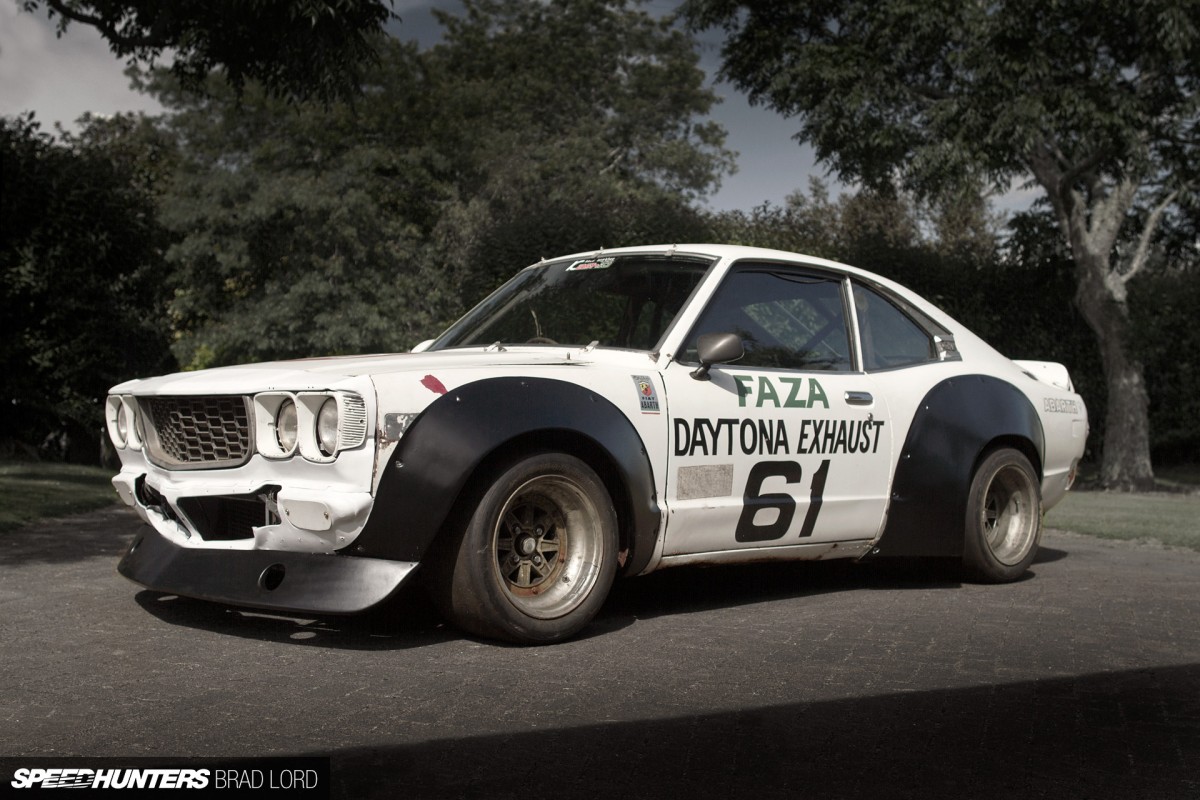
Prior to being invited to take a look at the car, I had heard murmurings about an old ex-IMSA RX-3 race car in New Zealand, and given the numbers of historically significant machines that have found their way to this country, I absolutely believed it to be true. But to be standing in front of this car, this time capsule from the JTCC’s glory days, is really something else.
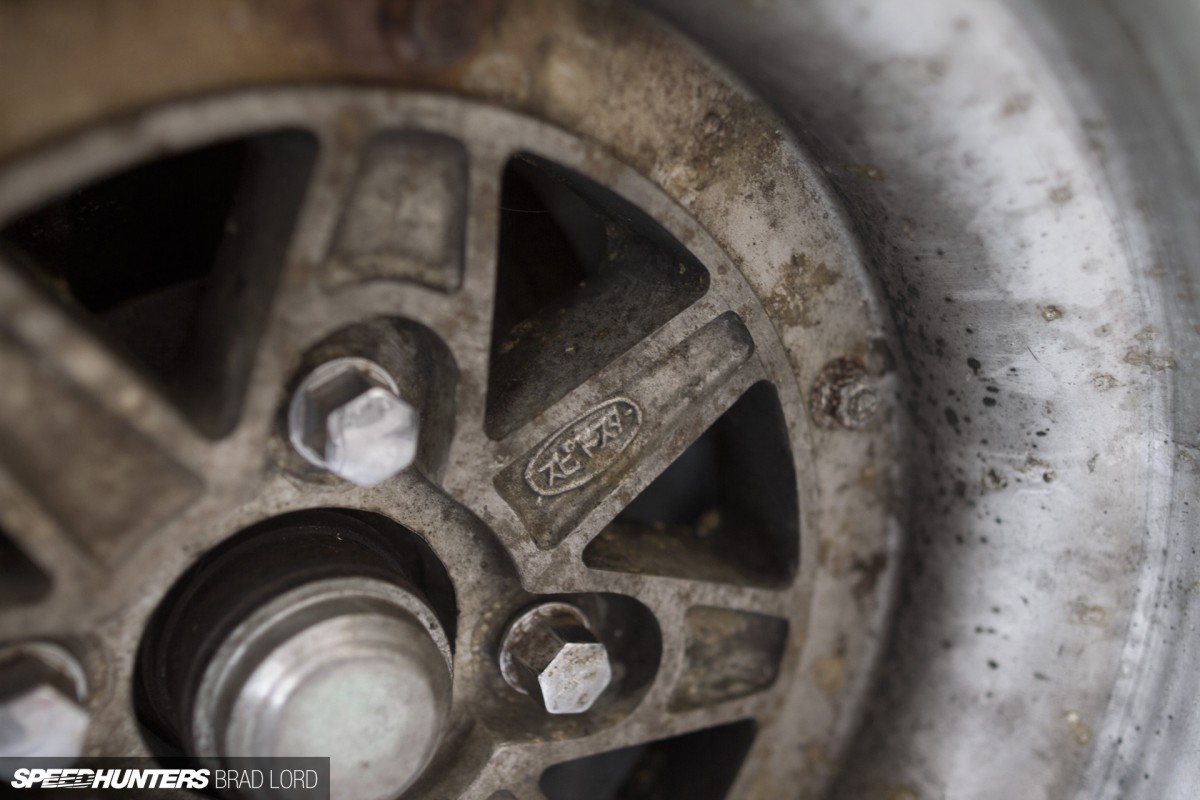
Right now, the only thing better would be switching the ignition, priming the fuel system and firing this great survivor into life. Given the time it’s spent sitting idle, that’s not going to happen today unfortunately, but when new custodian Gavin Hicks is finished with it, it’ll not only run, but it’ll be headed back to the circuit again. The ultimate goal is to return it to Japan for a JCCA racing meeting at Fuji Speedway.
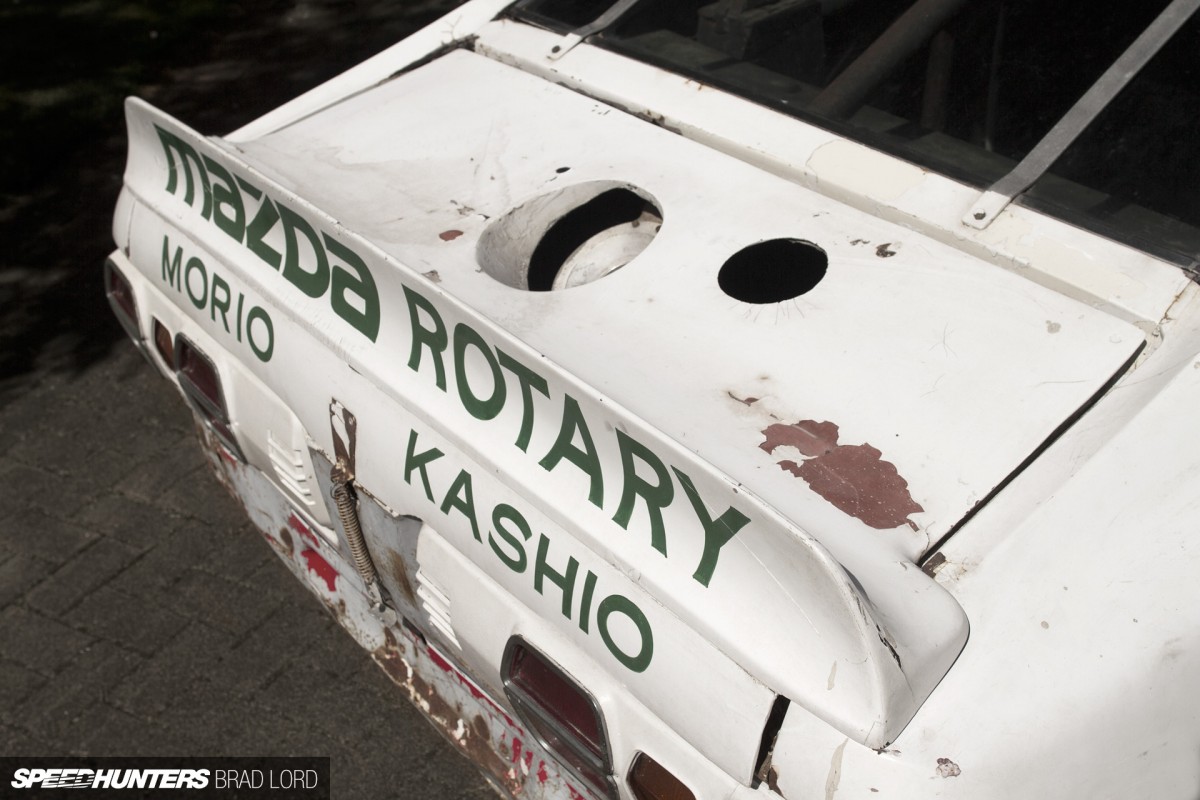
Looking at some of Gavin and his sons’ previous restoration projects and the amazing collection of cars they’ve amassed in the process of returning classic race and road cars to their original glory – something perhaps worthy a story on its own – I really don’t think this amazing slice of JTCC history could have gone to a better home.
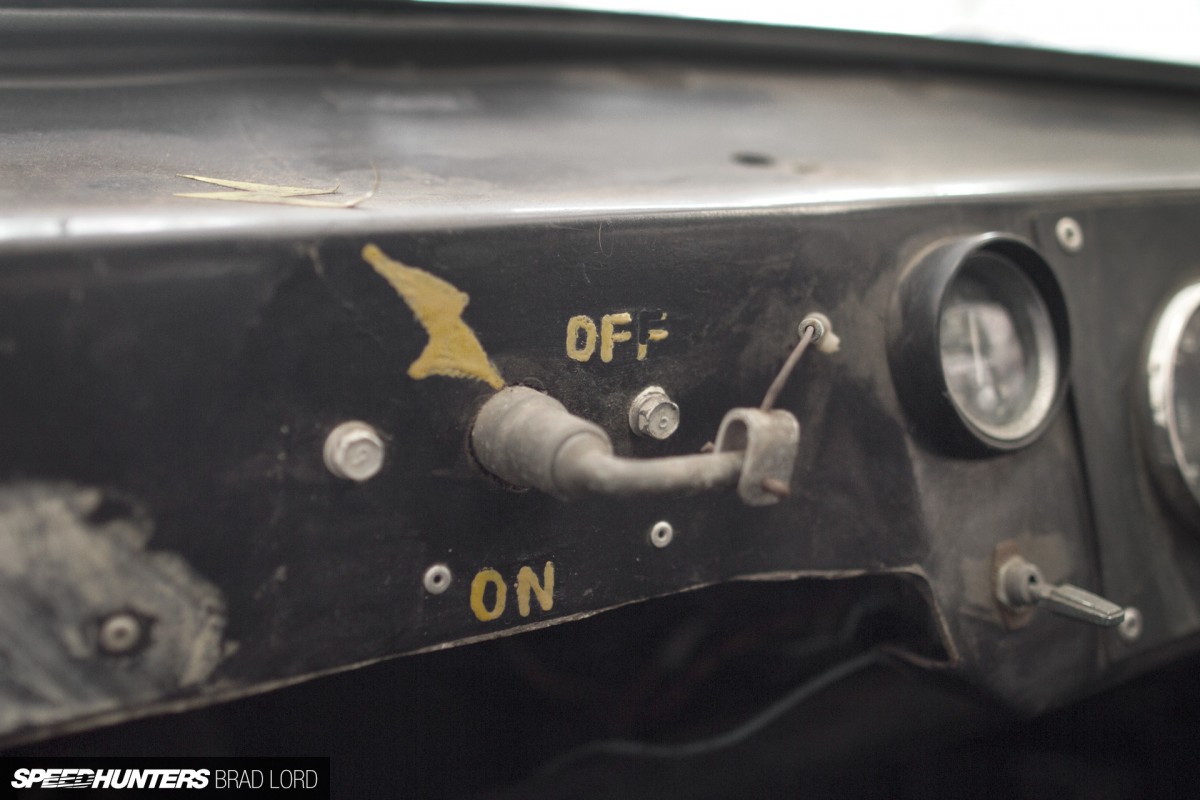
Not only is the RX-3 a great find though, but it’s also a great mystery. Although the latter years of its racing life in the USA are largely accounted for, it’s the five or so years before that – while the car was still in Japan – that Gavin would love to ascertain.

Before we delve into that though, we need to talk about the IMSA connection, which came about when the late American driver Al Cosentino ran the car in the 1978 24 Hours of Daytona event with Craig Fisher (USA) and Taku Akaike (Japan). Although the larger-than-life Cosentino’s first passion was Italian metal – and specifically those born out of Fiat’s Abarth tuning arm – dealings on both side of the Pacific Ocean during the 1970s ultimately led him down the rotary path. A connection at Mazda Japan arranged a test drive of a works RX-3 at FISCO (Fuji Speedway) in 1977, and although that particular car wasn’t for sale, Cosentino eventually found what he was looking for in another ex-JTCC Savanna coupe.
Charting history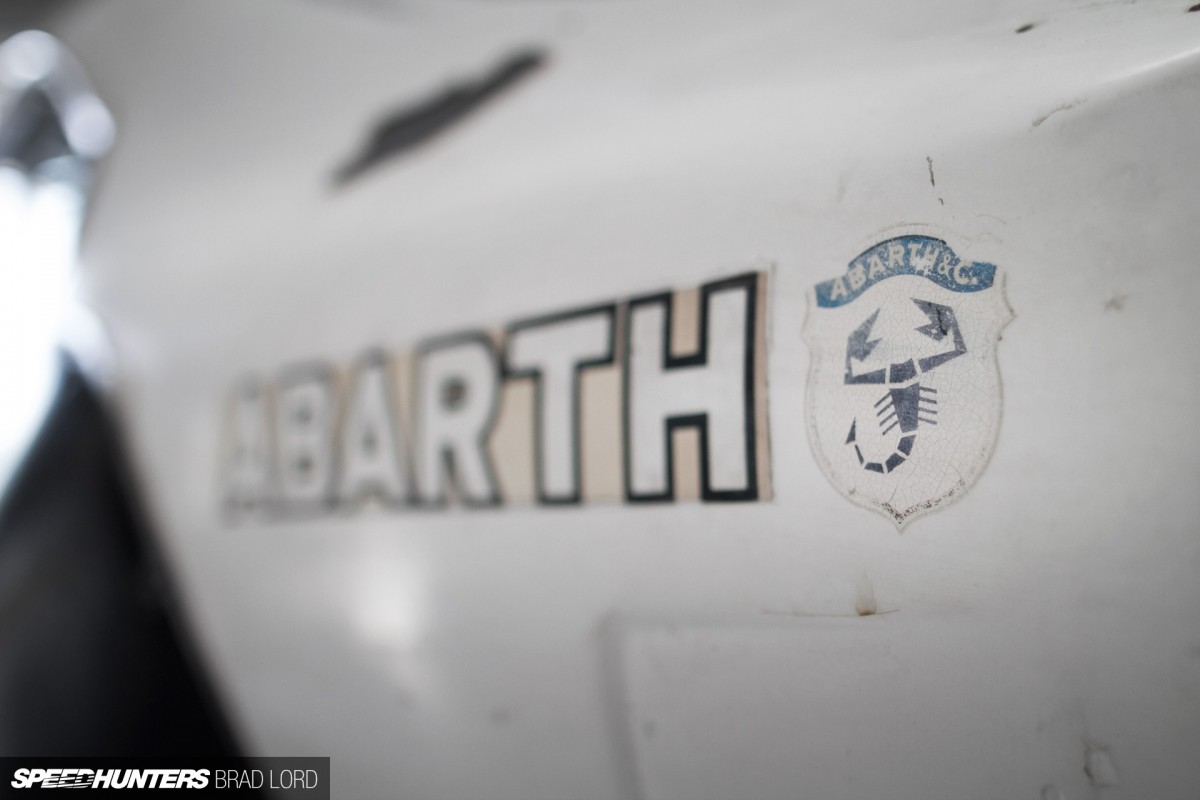
The RX-3 purchase – which was only finalised after Cosentino was able to test the car at the Daytona event – was made through Demon Company Ltd in Tokyo. It’s not known if Demon was selling the Mazda directly, or simply just brokering the deal, but the latter seems more likely as its owner Shiro Kosaka was a prolific collector of Abarth cars too. Cosentino’s Abarth-tuning prowess is what he’s best remembered for, and given that’s all his company FAZA was involved with, goes some way in explaining the out-of-place logos peppered all around the bodywork.
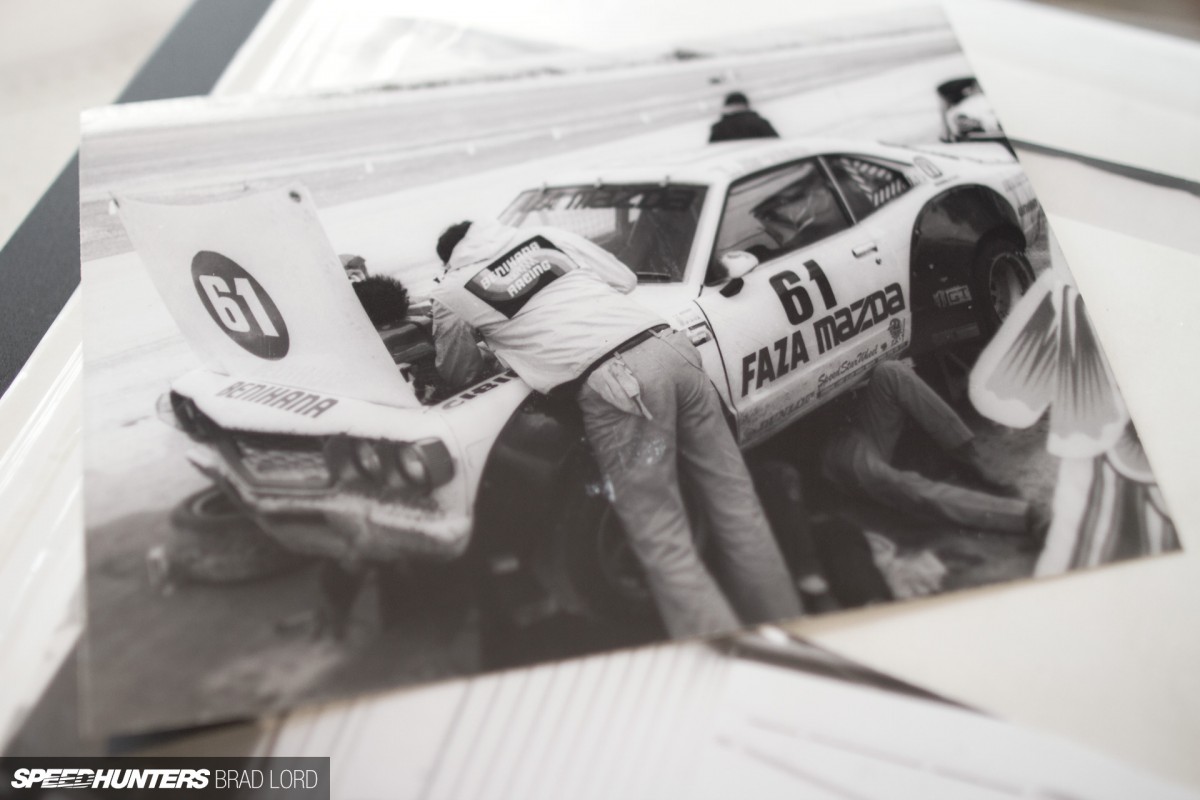
Along with the RX-3, Cosentino built and raced a brand new series one SA22C RX-7, so it’s unclear just how many races the coupe competed in, how it fared, or exactly when it was retired to the basement in his house. It certainly wasn’t any later than 1982 though. By all accounts, he was an interesting and intelligent, but somewhat eccentric man, but whether Cosentino just skipped around constant questions of the cars’ whereabouts, or purposely led anyone who asked off the scent is not quite clear; before the cars were uncovered a few years ago, it was widely accepted that they were long gone and had most likely been sold off in parts. Amazingly, that wasn’t the case though.

How the RX-3 (and the RX-7 for that matter) came to be in New Zealand as part of the Hicks collection was completely by chance too. While purchasing some 15×13-inch Campagnolo wheels for a Maserati restoration, Gavin found out that the broker at the centre of the negotiation had bought Cosentino’s entire FAZA estate, and was in the process of selling off all the remaining stock and some of the cars in the collection. After researching the two Mazdas and their IMSA history, it was decided that the opportunity to purchase both of them was simply too good to pass up, and the deal was done.
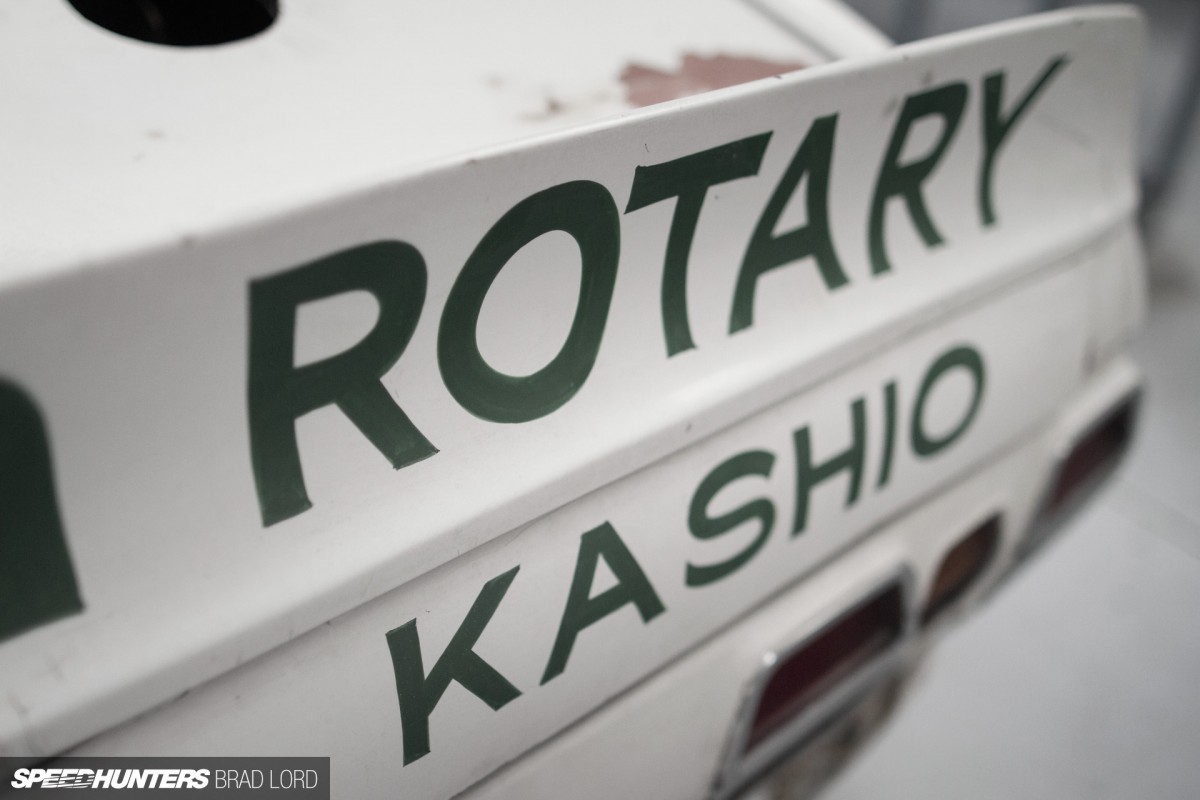
With multiple other restoration projects in the works, the RX-3 has been on the back burner since they acquired it a couple of years ago, but Gavin and his sons have used the time wisely, exhausting every avenue they could in the quest to find out exactly what they have, and how it should be restored.
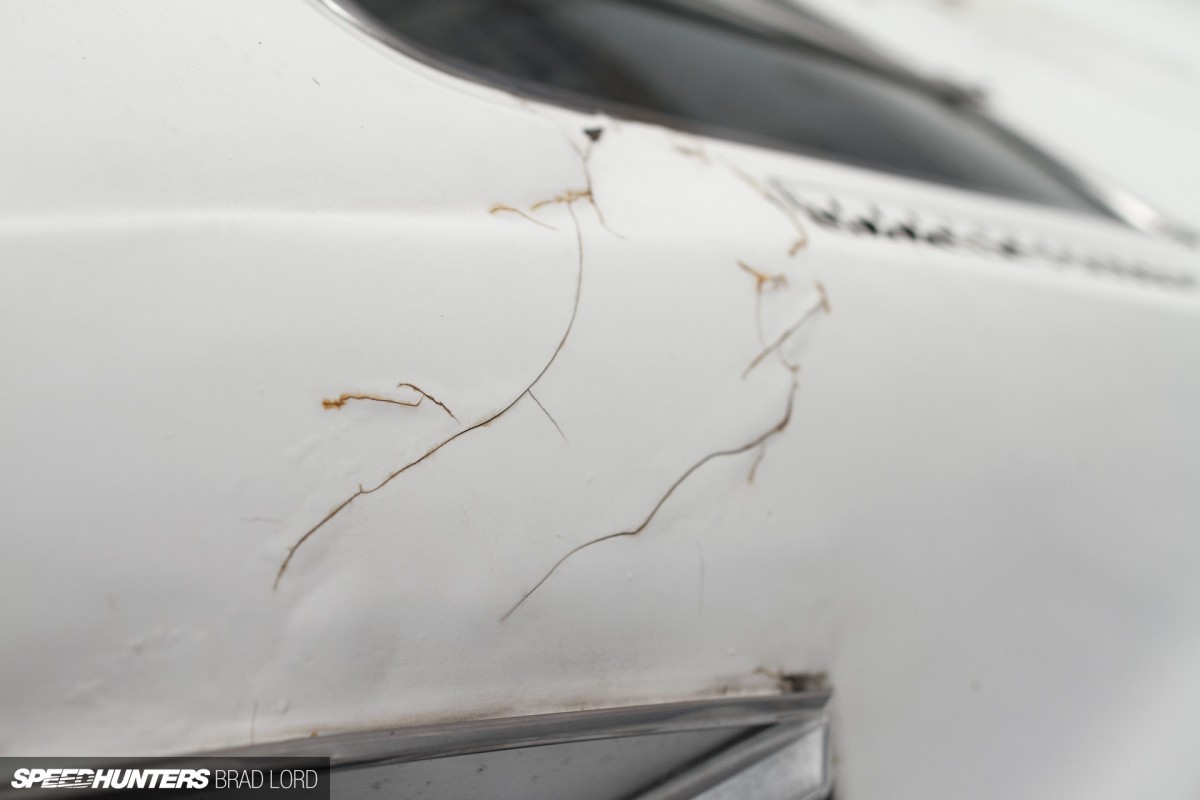
Considering how complete the Mazda is, and the hundreds of photos included in a dossier that came with it, reinstating the car to its former IMSA glory would be a straightforward proposition. But it’s the RX-3’s Japanese heritage that the family are most interested in uncovering before any decisions on the car’s restoration fate are made.
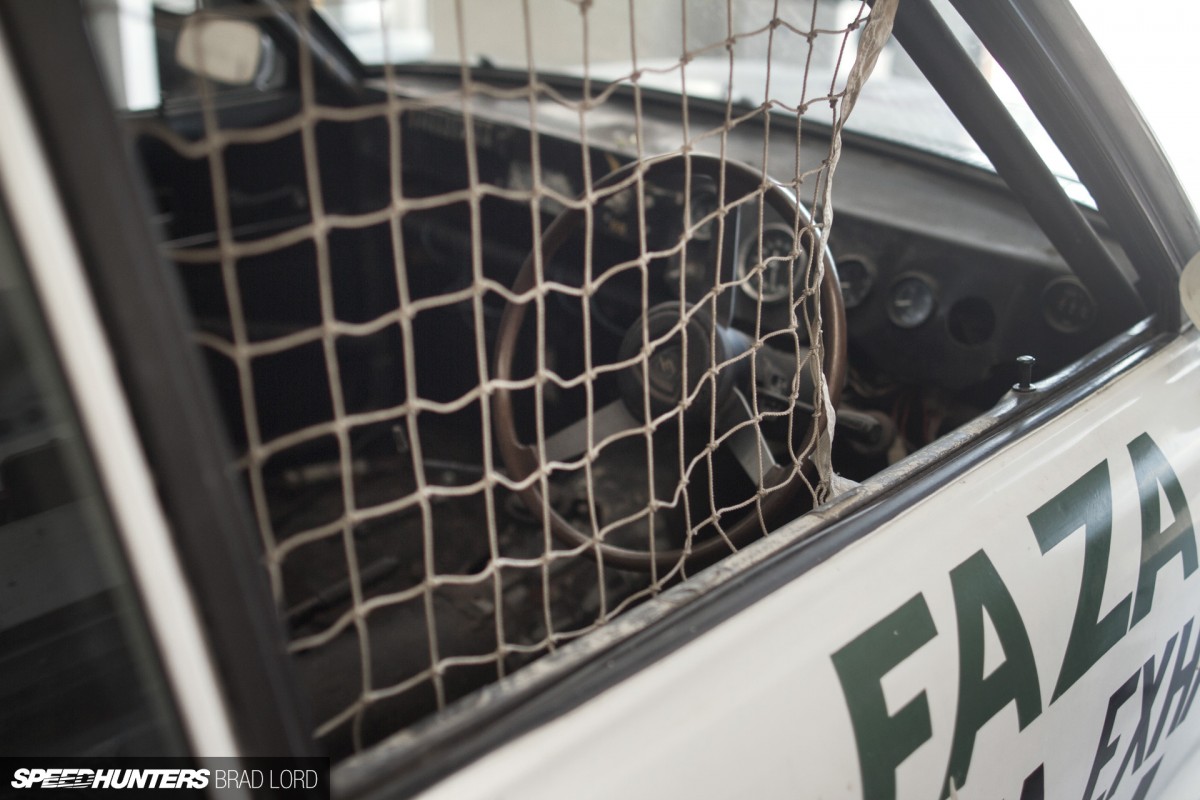
To date, that hasn’t been an easy proposition though. A trip to Japan, the purchase of numerous Japanese racing magazines from the era and countless hours spent trawling the internet for leads have failed to turn up any concrete information on who originally built the car, who drove it, and exactly how it looked when it first raced. There are however, plenty of clues to its former life…
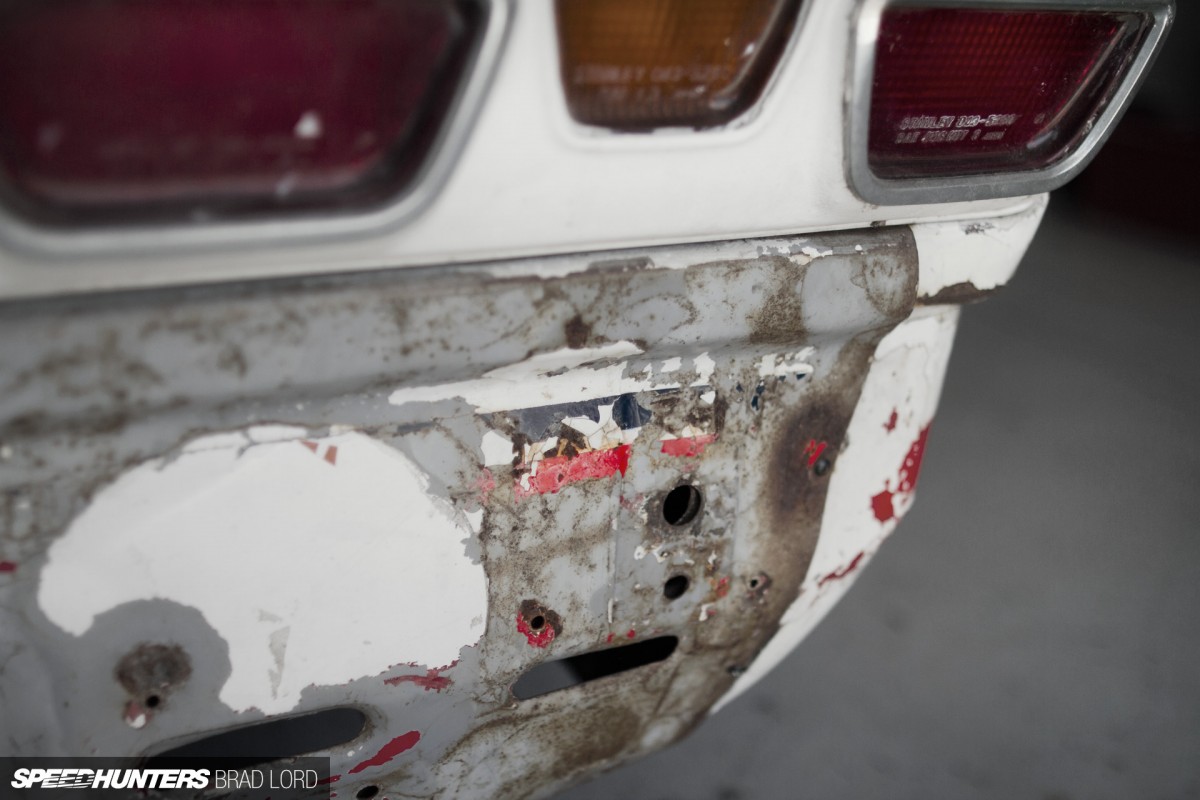
While the RX-3 might have only raced in the US with the same basic white and black scheme it’s presented in today, there are hints of former livieries around the bodywork. The crudely attached rear lower valance for instance, shows signs of an off-white base – the factory colour perhaps – with a thick red band that runs to the bottom of the panel split by a thin blue stripe. Although the paint around the rest of the car has yet to be painstakingly wet sanded back layer-by-layer, it does appear as though the same scheme continues along the side of the Mazda’s body.
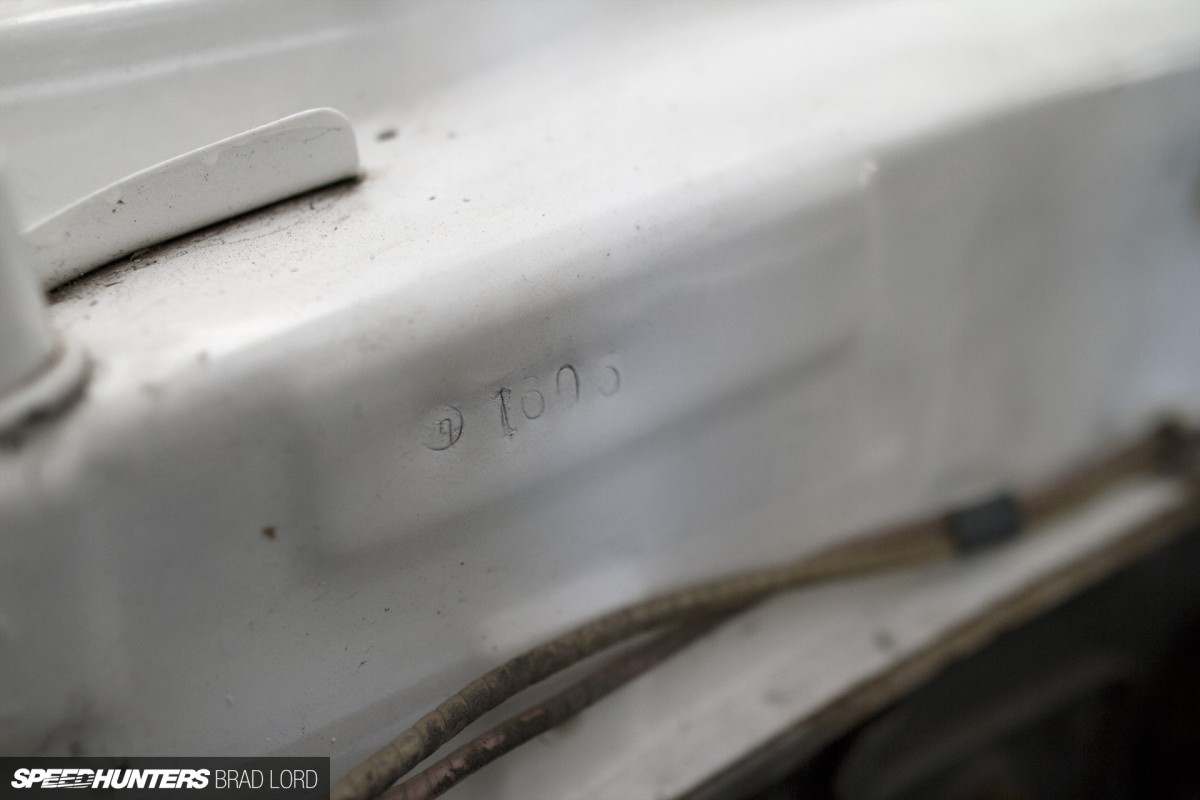
And then there’s the chassis number. Depending on engine configuration, RX-3 coupes have prefix of S102A- or S124A- followed by their unique frame number. This car has a period Mazda ‘M’ logo stamp, followed by the numbers ‘1605’. Considering that the panel doesn’t show signs of ever having been replaced or altered in any way, what does this code mean? The most likely scenario points to the car being a ‘white body’ model – a semi-complete white chassis plucked incomplete from the production line with the sole intention of being turned into a race car.
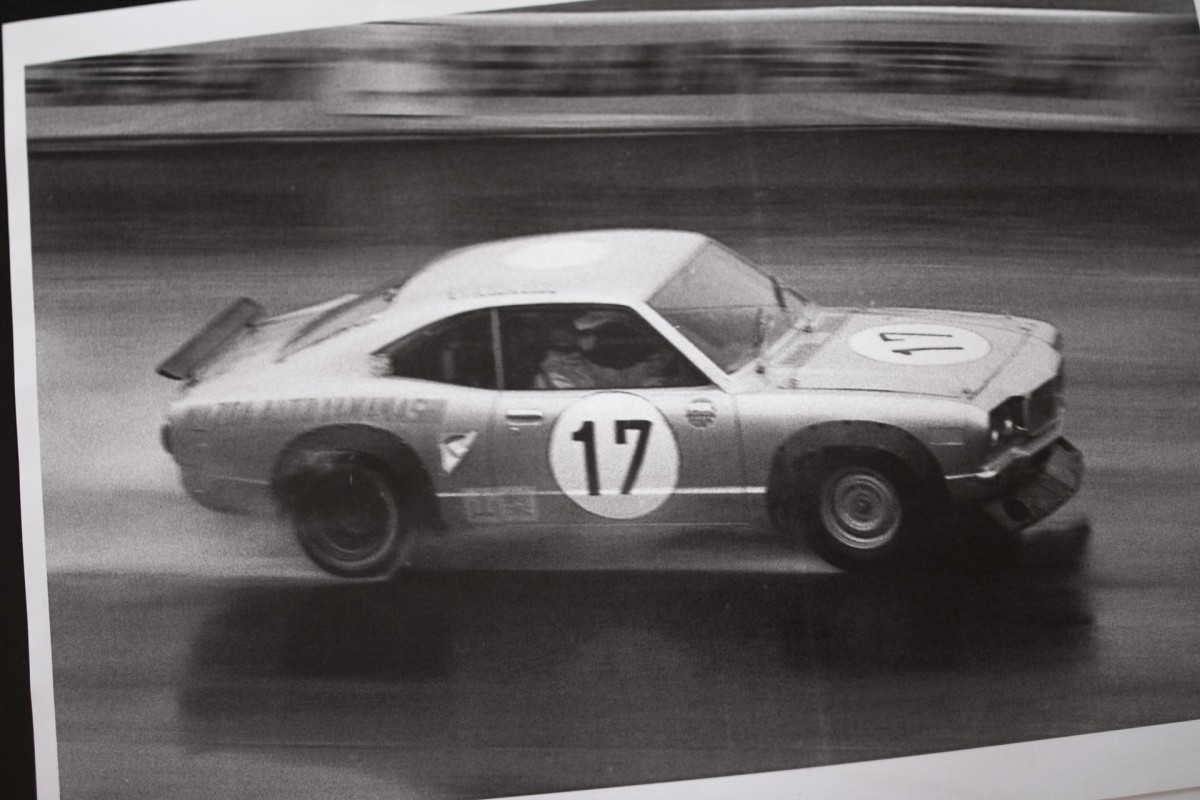
Perhaps the most crucial link to this story is the late Japanese racing driver Taku Akaike, whose name appeared on the roof edge above the driver’s door when it arrived in the United States. JAF records reveal that Akaike raced all manner of machinery right up into the 1990s, including a 13B-powered Lola T280, and even a four-rotor 767B. Of most interest though is the S124A Savanna RX-3 from 1972 through to 1977, competing in numerous JTCC events at Fuji Speedway under the ‘Mazda Auto Yamanashi’ banner. What isn’t known is whether or not he always used the same silver-coloured car as shown in a small handful of images that have been found so far, or whether there were multiple RX-3s involved. It’s been suggested that he ran a race car preparation workshop – which perhaps had something to do with the Yamanashi dealership – so the latter is something that can’t be discounted either.
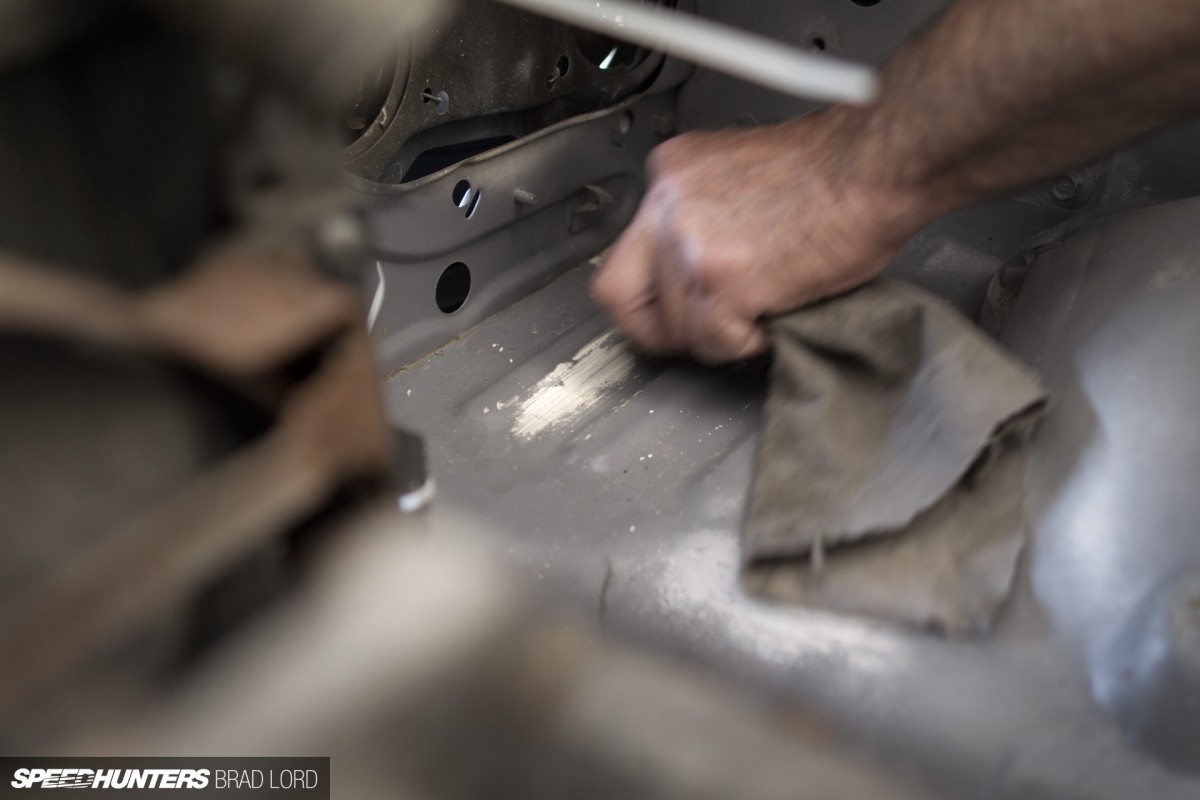
The topic of colour is an interesting one too, because wiping away a thin layer of can-sprayed flat grey in the engine bay reveals previous layers of paint. And along with the white base, this area of the car was sprayed silver at some point.
The right stuff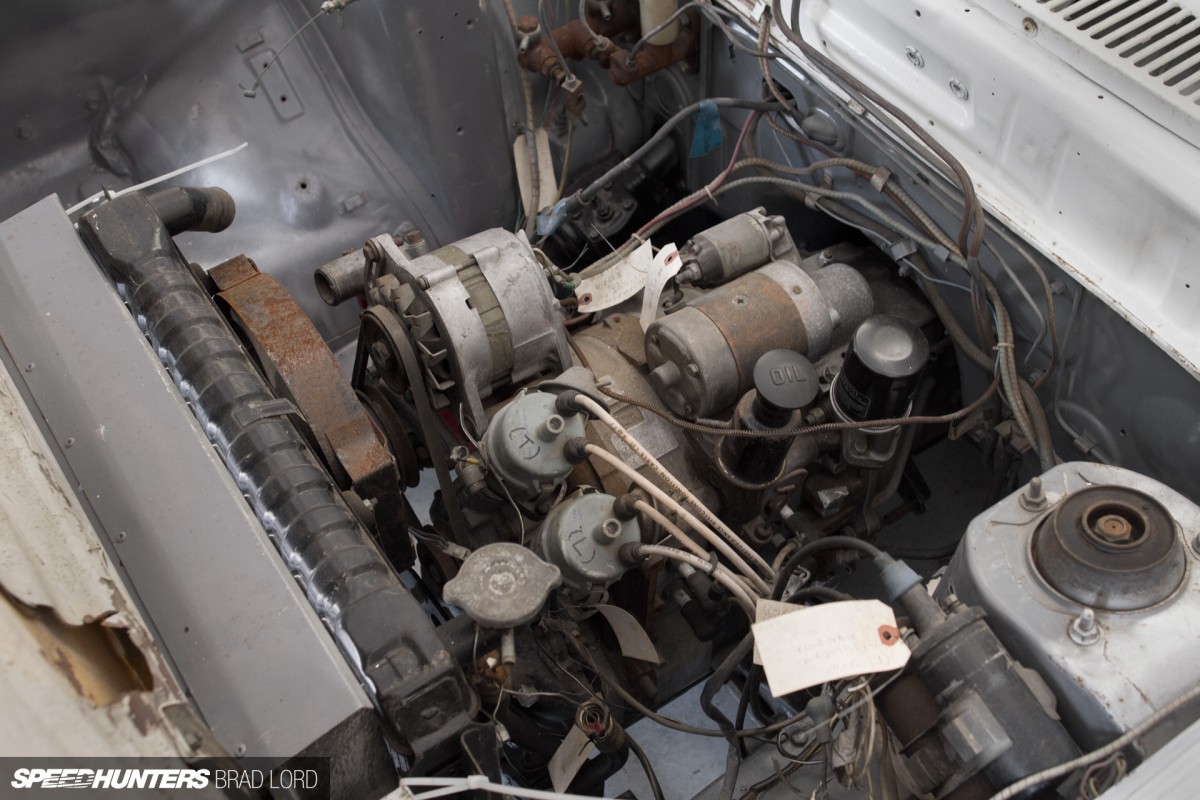
Prior to seeing the car I wasn’t sure whether it would still have an engine with it. But not only does it have one, but it could well be the same 12A twin-rotor twin dizzy motor that powered the car when it was first built and raced.
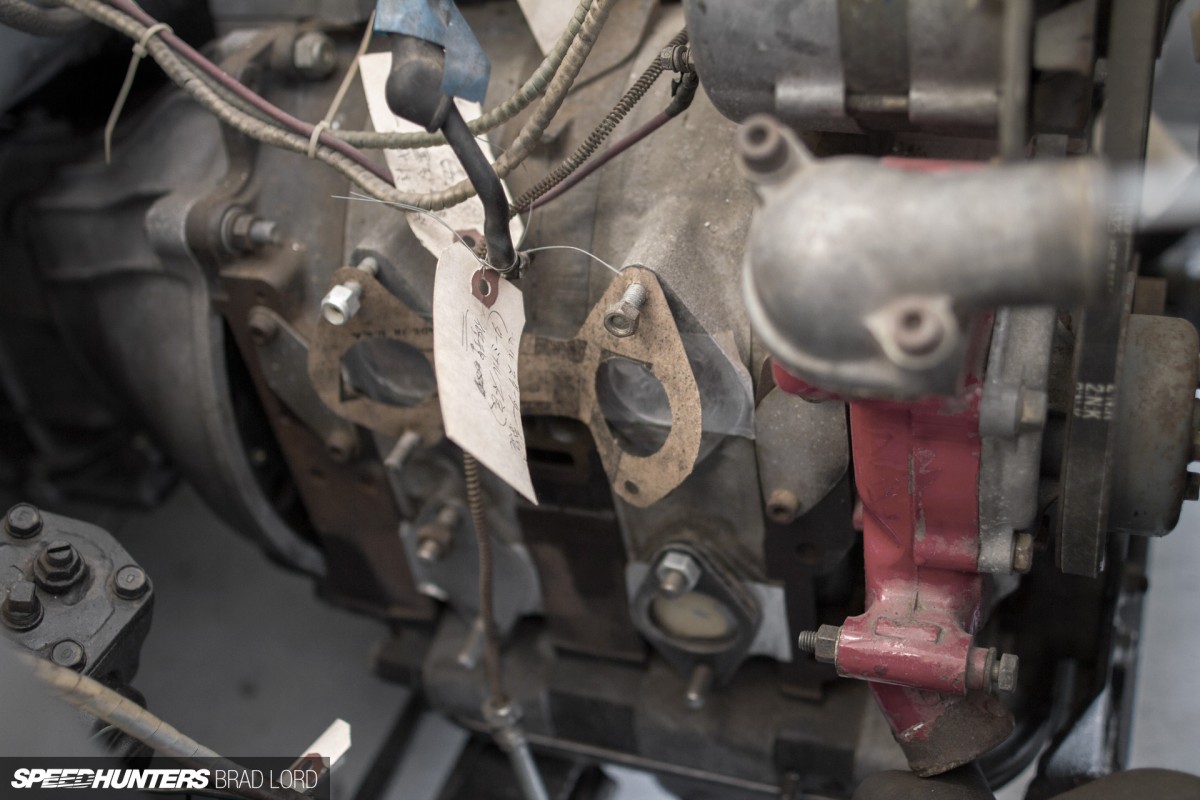
Of course, it’s no ordinary 12A, but a proper racing engine featuring sand-cast MFR (Mazda Factory Race) peripheral port rotor housings. The setup uses a 48mm Weber IDA carburettor and a crazy megaphone exhaust system which were both came in an extensive inventory of spare parts that were included in the sale of the car, and according to associated paperwork, suggests it was good for 270 horsepower at 9,000rpm.
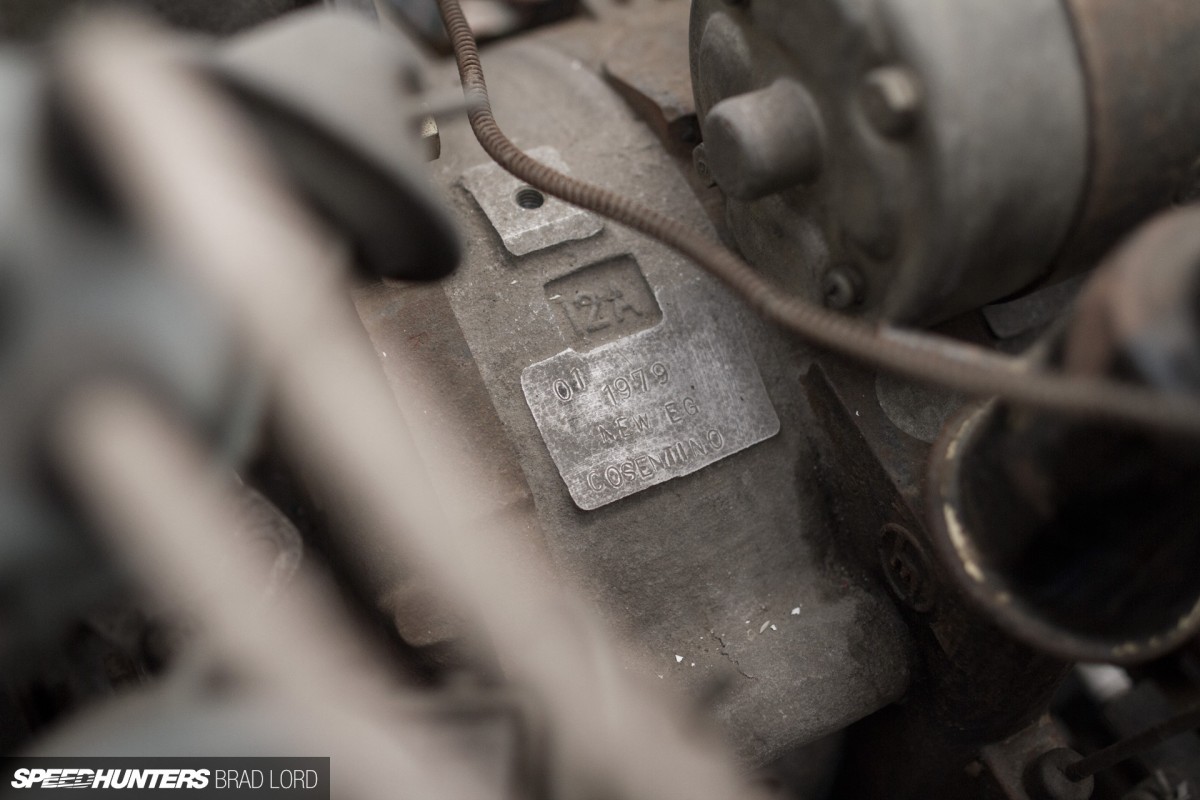
Because of their problematic apex seals and mediocre water seals, you generally won’t find a 12A twin dizzy engine at the top of anyone’s wish list, but considering this is essentially a factory race engine – and its probable long-time connection to the car – it’s the right motor for the restoration. According to that stamping, this particular engine was refreshed for Cosentino in January 1979.
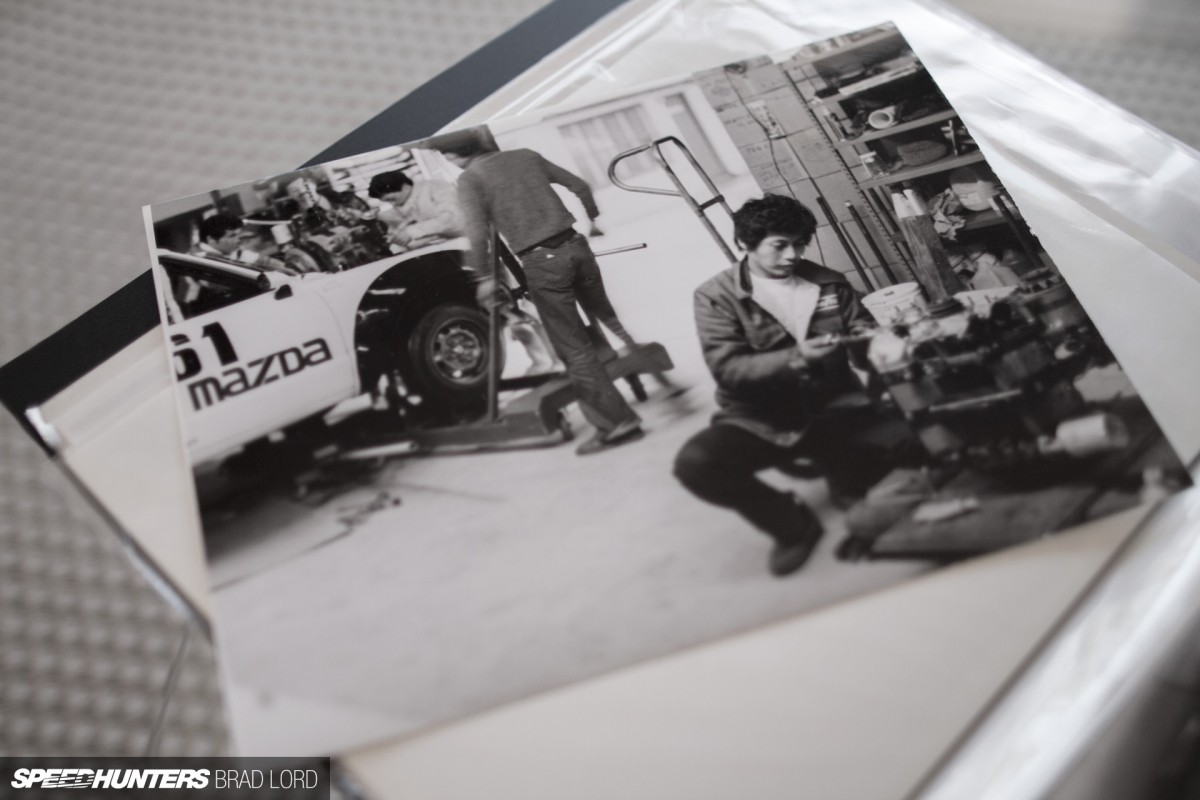
That’s a job which was looked after by rotary engine specialist Morio Kashio, of Kashio Race Service. Although details are thin, it appears as though Cosentino would fly Morio and a small team of mechanics in from Japan especially for IMSA race weekends.

Not a lot is known about Kashio-san’s workshop, which appears to have been based out of Wakayama in the Kansei region, nor the man himself, whose name remains emblazoned across the bottom of the boot lid. If his whereabouts were known, I’m sure he’d be able to fill in many of the missing pieces surrounding this car.
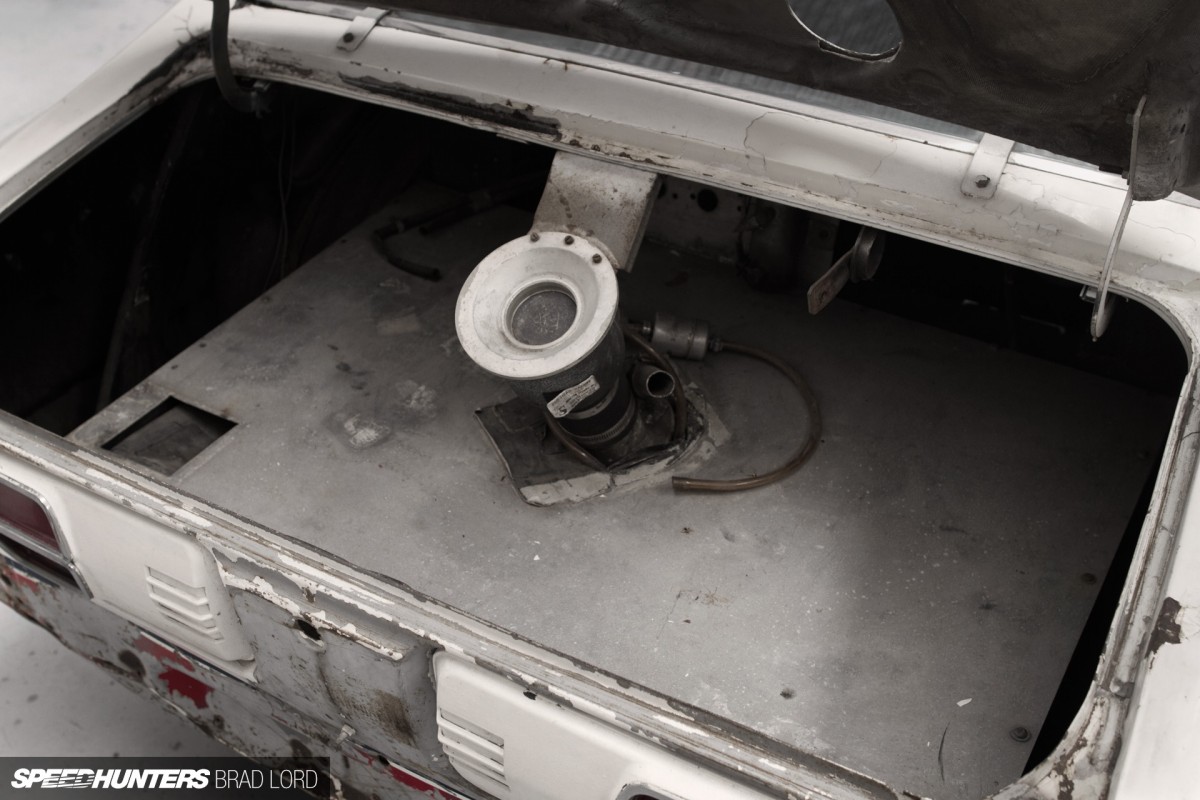
It seems as though the large-capacity fuel tank and dry break filler might have been installed in the US, but it’s hard to tell given that the car competed in endurance events in Japan too. It’s a neat addition all the same.
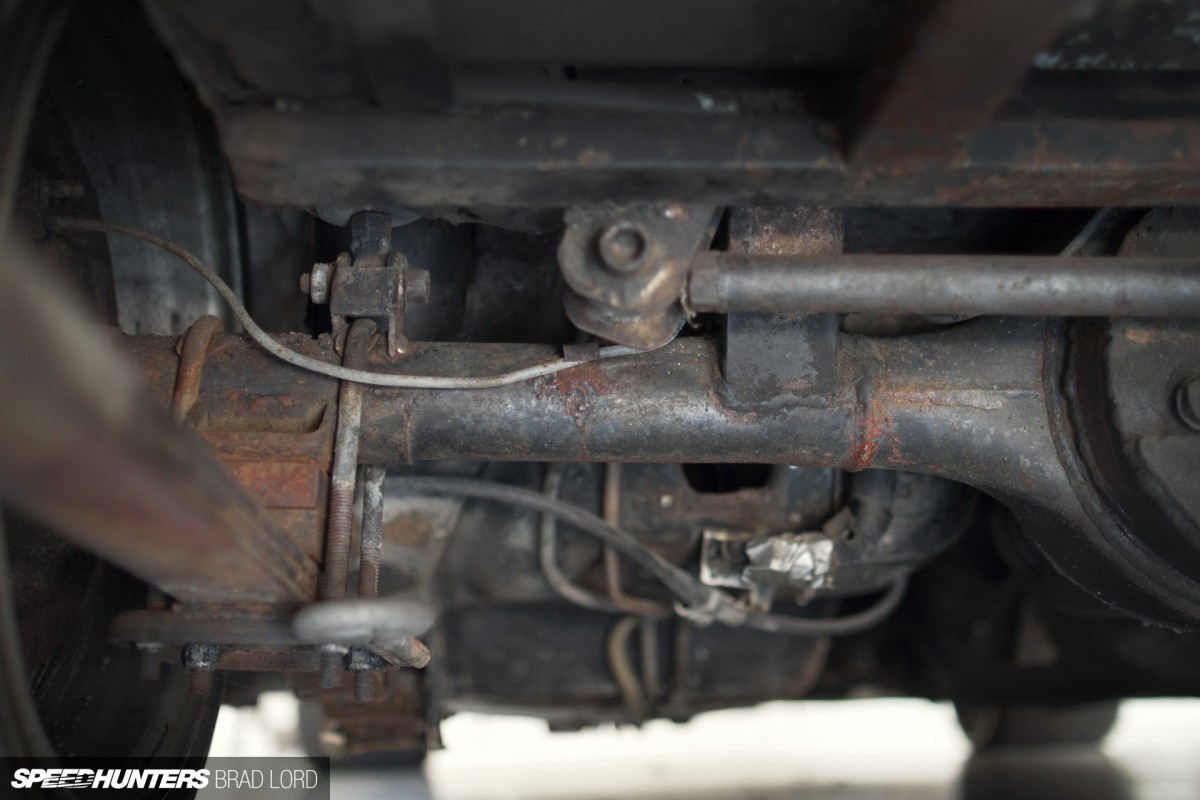
Likewise, beneath the car are a number of interesting and quite ingenious modifications that have been made to improve handling. Along with a four-link set-up, the diff has noticeable bends which would have had some bearing on rear wheel camber angle. As you can see, blocks are used to set the ride height lower too.
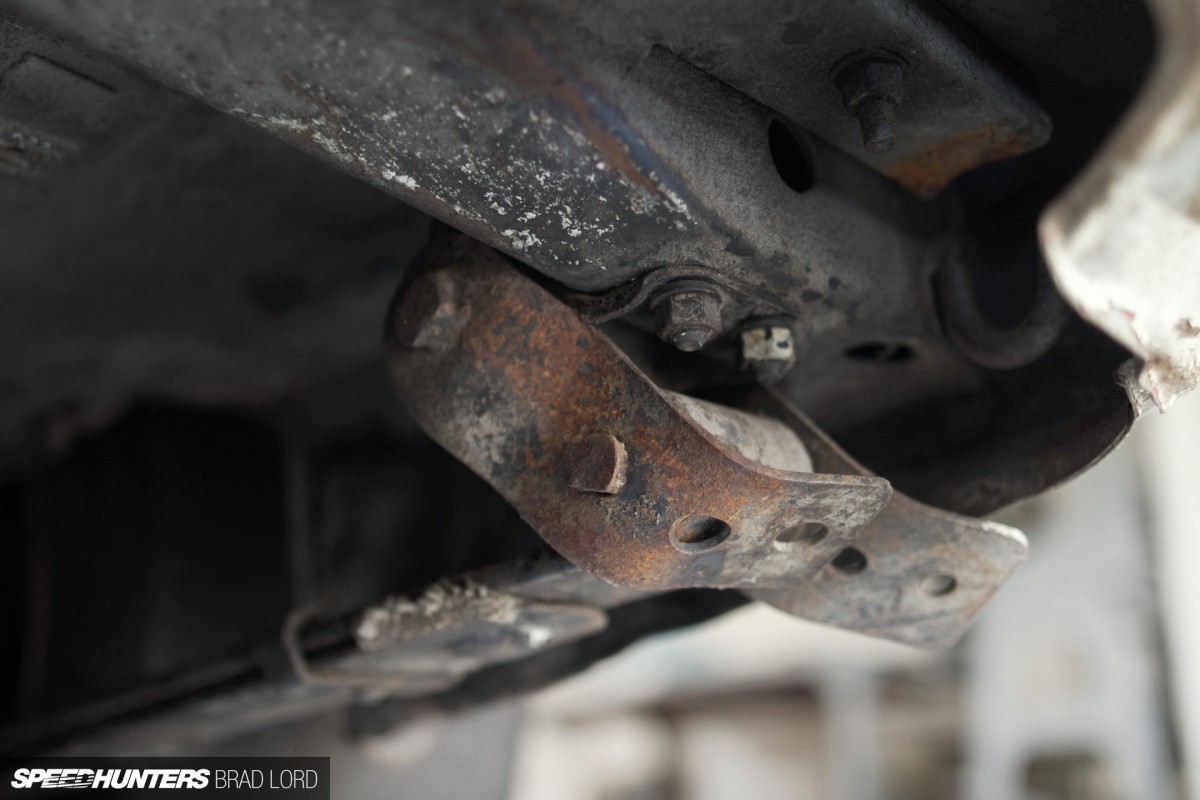
At the back end of the leaves the set-up is a little different, with brackets employed to allow easy adjustment of the spring angle. Not so much with it all bent up like that though.
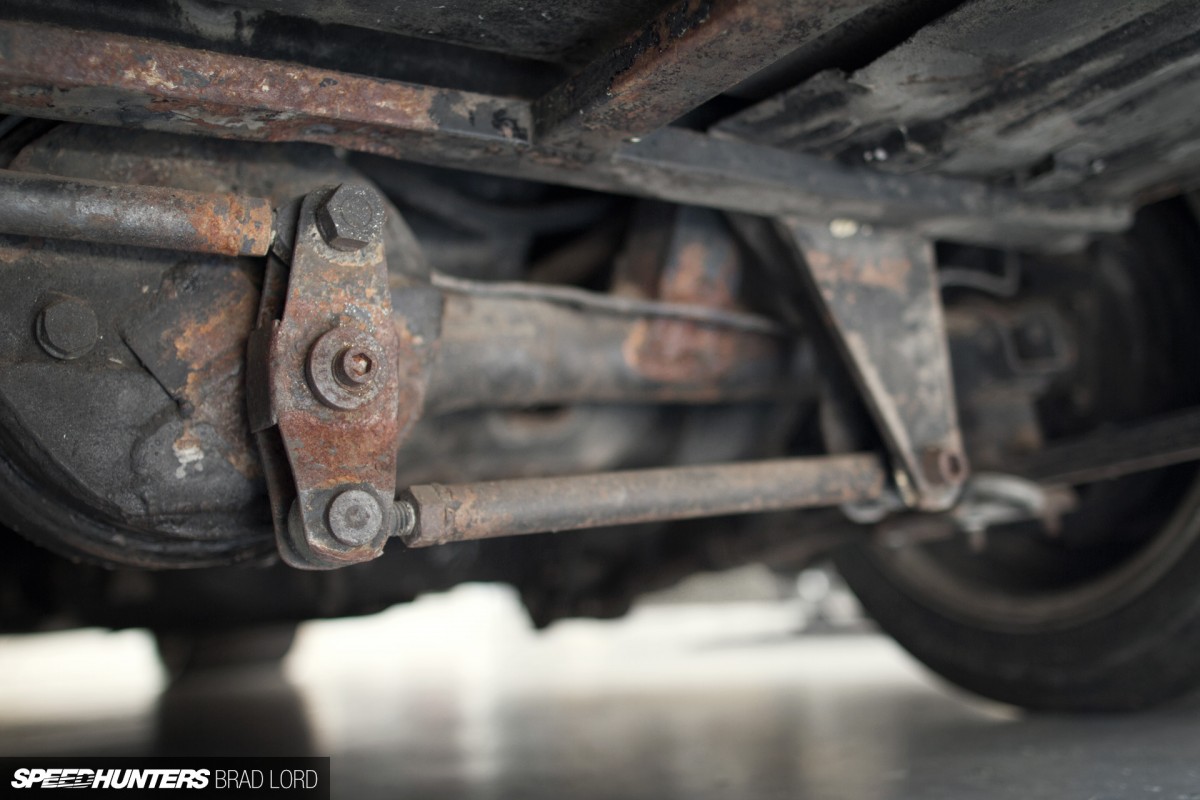
And to realign the rear axle after lowering, a Watts link with rose-jointed ends has been added. I’ve read that this was a modification that Mazda made to its factory-backed and works-built RX-3 race cars, but I assume privateer teams would have followed suit too. It does make you wonder though, doesn’t it?
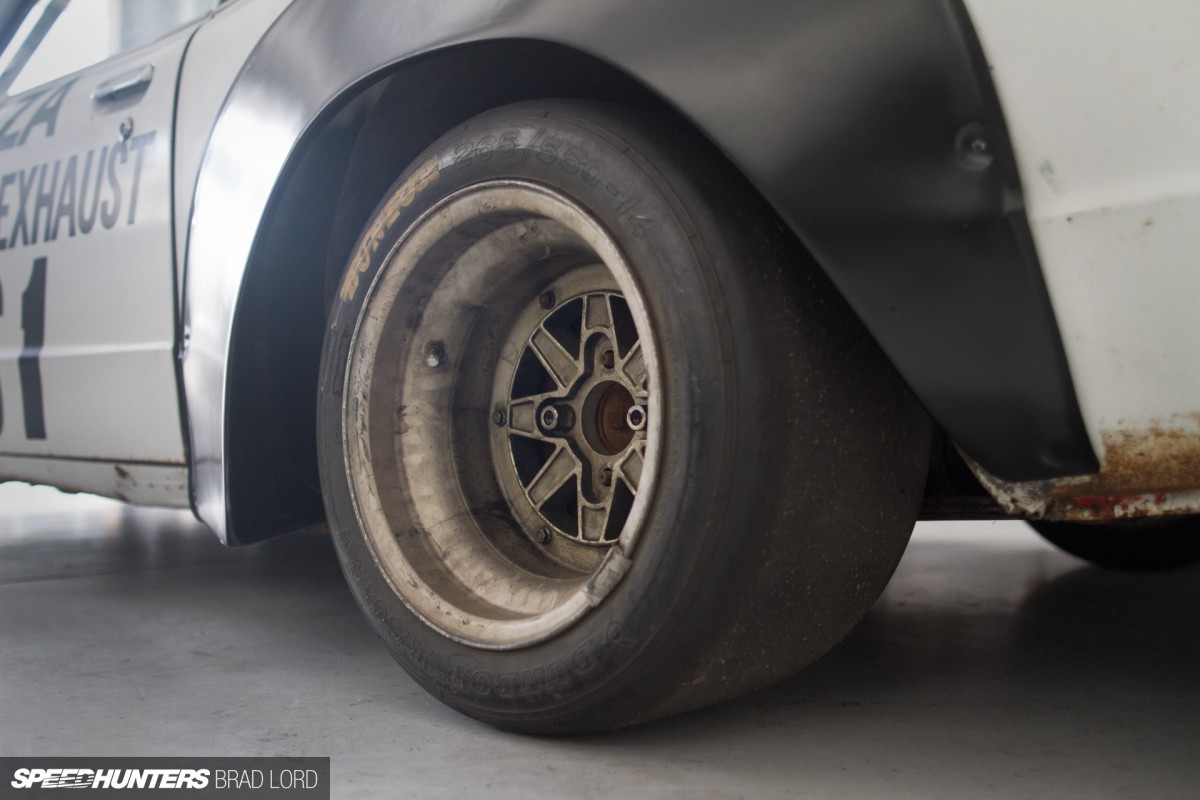
One of the defining features of the RX-3 are its wheels, and photos of the car when it first arrived in the US suggest that its former Japanese driver enjoyed some sort of sponsorship from Speed Star Racing. Not only are SSR MkIIIs one of my favourite vintage Japanese wheels, but measuring up at 14×9-inch on the front end, and 14×11-inch at the rear, they’re some of the biggest I’ve ever seen. The Dunlop Racing tyres are the last ones the car raced on, so they’re definitely period correct!
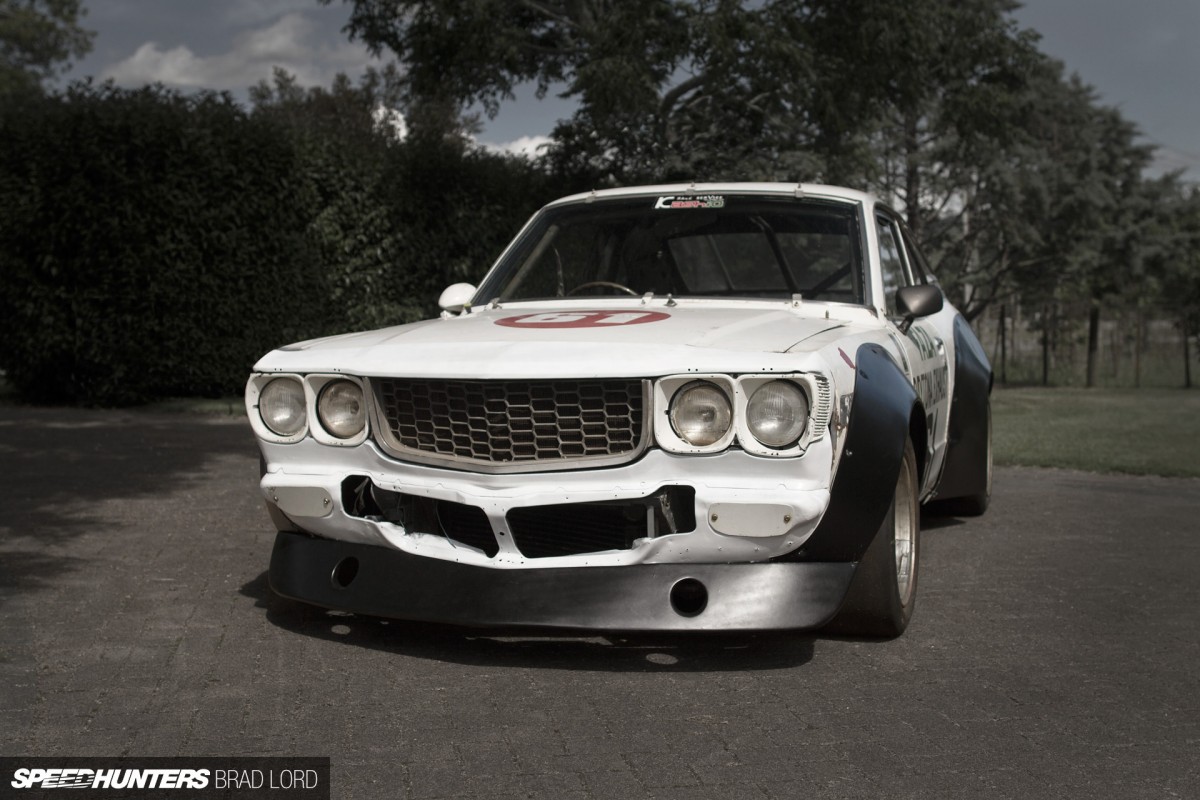
Wide wheels required wide wheel arches, and although the rear wells were tubbed for extra clearance in JTCC RX-3s, large over fenders were still required. When this car was found, all four bolt-on fender extensions and the front air dam were missing, so these items are faithful replicas which married up to the existing mount points exactly. And speaking of holes, there are another set on each corner, suggesting that smaller over fenders as seen on early RX-3 race cars were indeed fitted at some point.
Some answers, many more questions
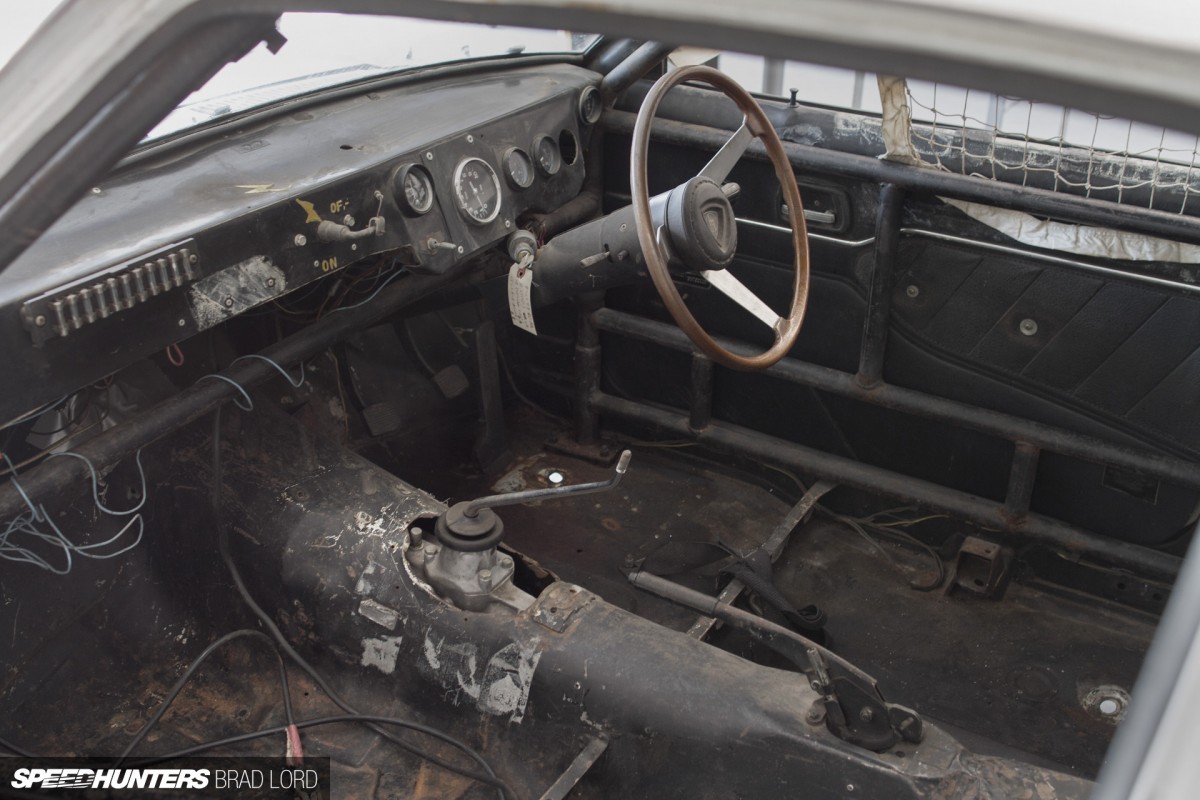
It’s hard to get inside a car like this one and not imagine the action that was seen and experienced from the driver’s seat. In this case it’s a little harder, because that’s one of only a few missing pieces that will need to be tracked down in due course.
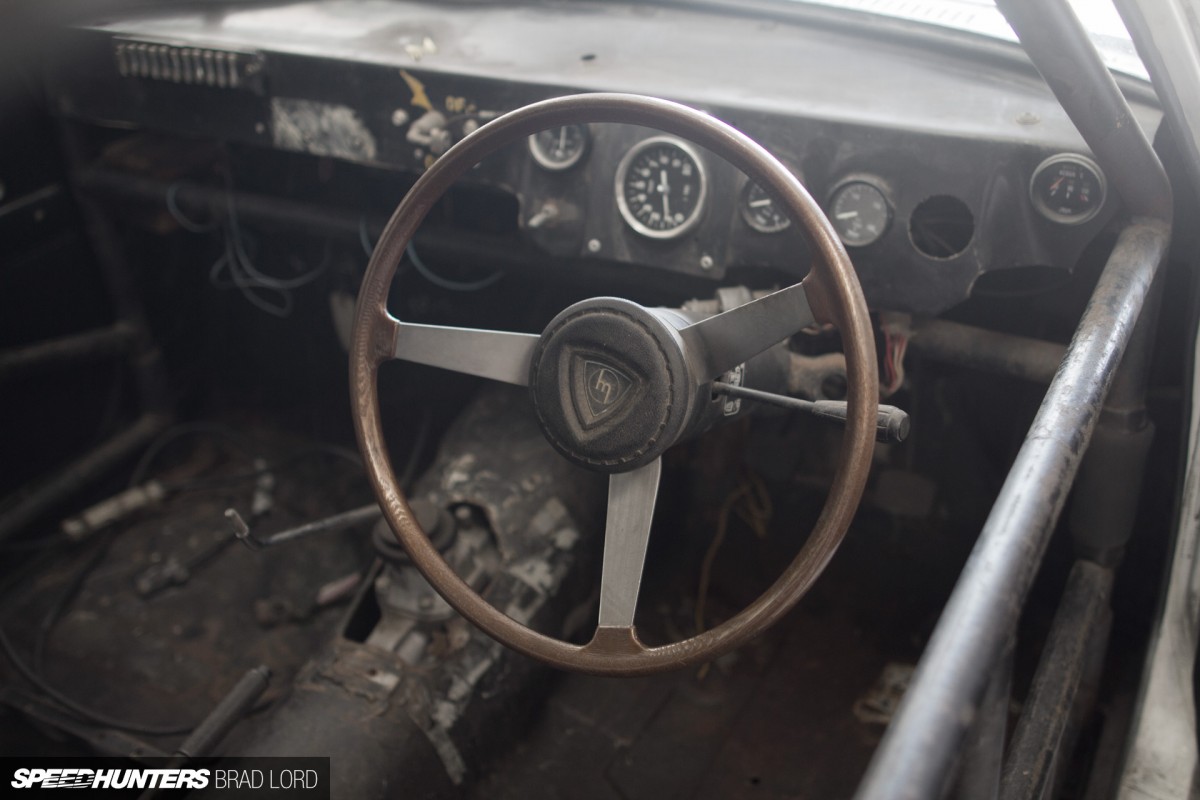
It’s pretty cool to see the original steering wheel still intact though. When you look back at old photos of RX-3s racing in Japan, the thin wood rims of the factory wheel are almost always visible over the top of the dashboard. Coupled with vague feel and feedback, these cars must have been a handful and a half to drive at the limit.
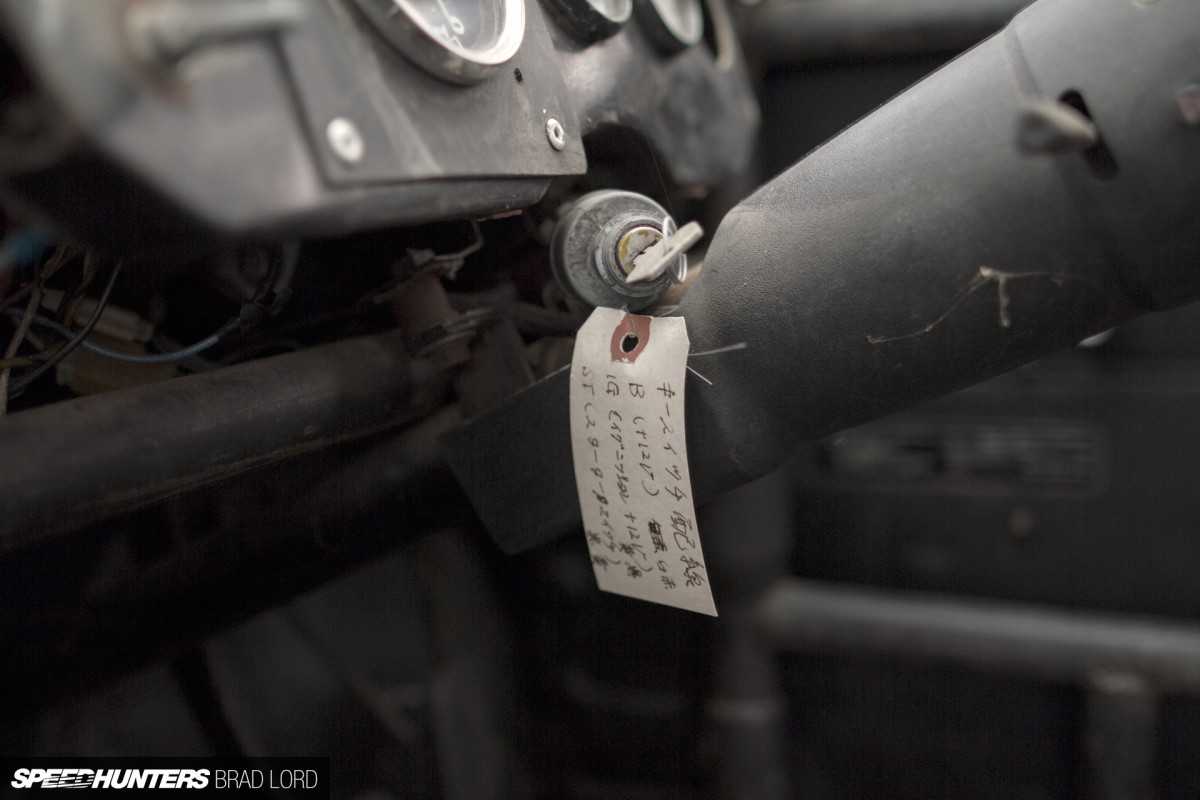
You might have noticed some little cardboard tags around the engine in the last chapter. They’re all over the car and seem to explain little nuances. For whatever reason, this one talks about the four positions of the key.
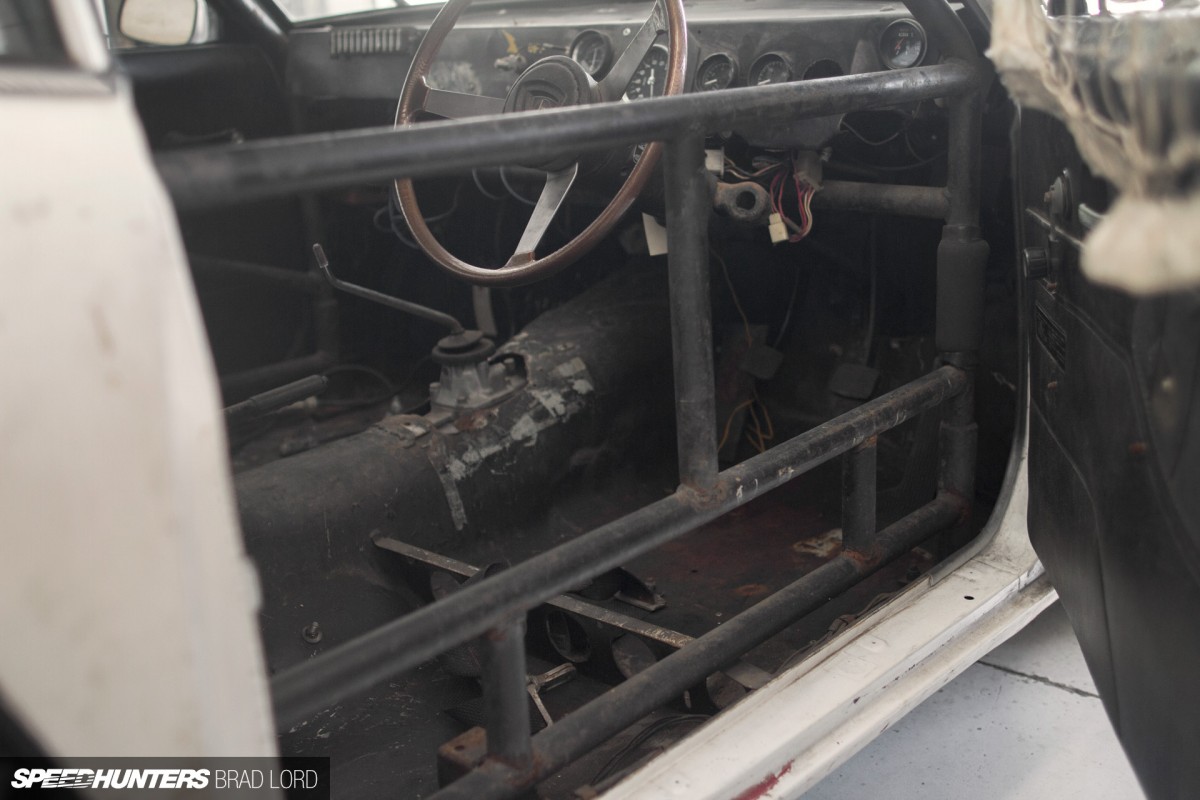
The folded fibreglass/metal dashboard features a couple of Omori Meter gauges, plus a few assumed to be later add-ons, including a Smiths 10,000rpm tachometer. Another non-original aspect are the extra roll cage bars behind the driver’s door, which have IMSA written all over them. If the car is taken back to one of its JTCC guises, anything like this that shouldn’t be there will be removed. Like previous restorations in the Hicks’ garage, maximum authenticity will be the number one priority.

Looking back in the interior space reveals the extent of the chassis reinforcement, extra wide wheel tubs and the hand-formed frame work for the aforementioned four-link. Ten years’ worth of racing and 30-odd years in storage has resulted in a fair amount of wear and tear, but right now it’s all part of the charm. All of this custom work will be retained of course, just cleaned up after dipping, repaired where required, and then repainted black as it originally was.
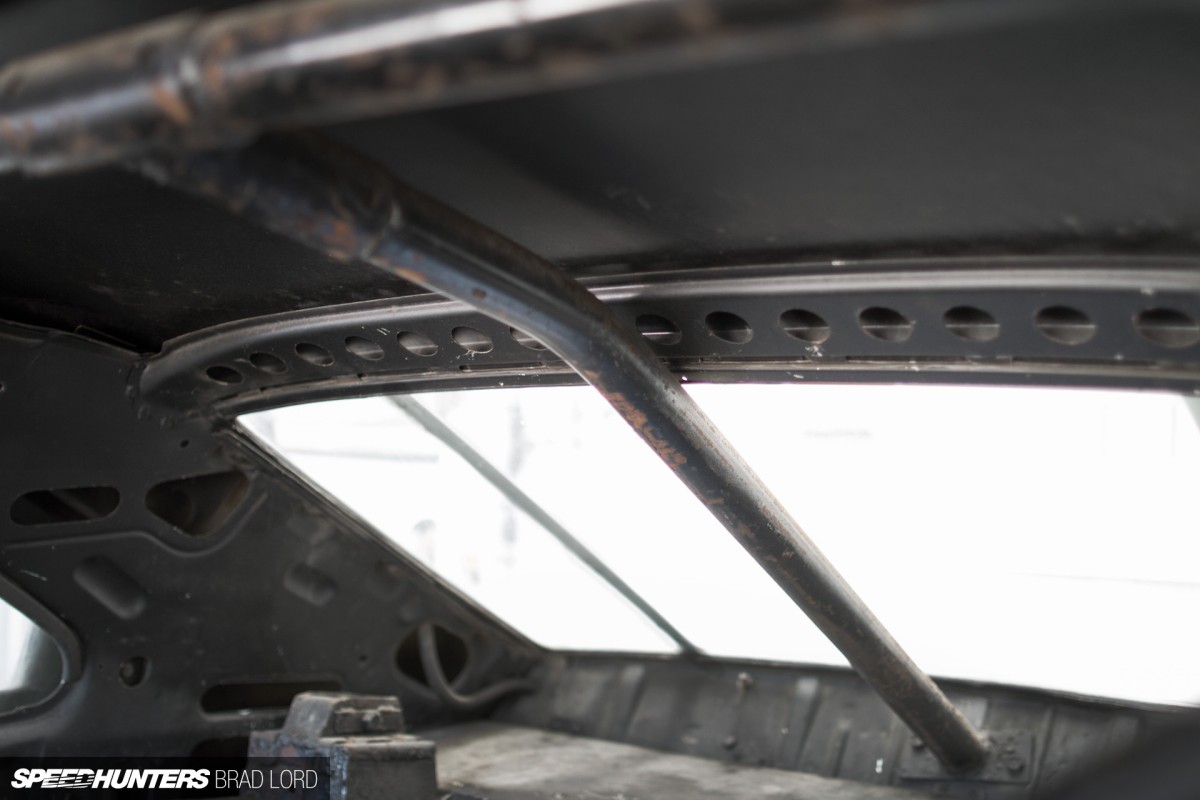
Throughout this post I’ve mentioned a few different details unique to the car that could possibly help with its identification. The roll cage – or more specifically – the single, central rear bar, is definitely another. Only early RX-3 race cars seemed to feature this style of roll cage and even then it wasn’t very common. That also supports the notion that this car is of ’72 or early ’73 vintage, and was updated with the series two nose cone and larger flares once that model began hitting showroom floors in late 1973. That makes perfect sense too given that the car’s naming right sponsor was a Mazda dealership, and therefore may have spent time on display and would need to look like the current model.
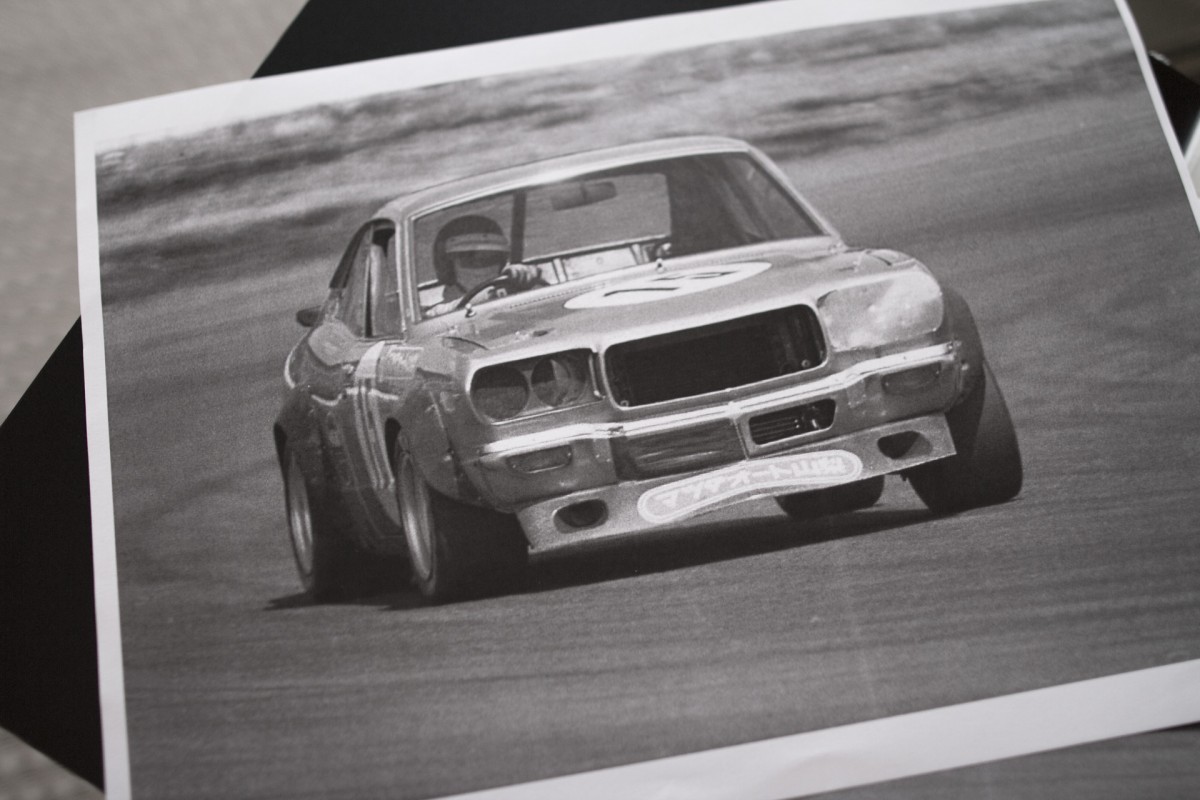
Here’s another shot of Akaike-san racing that silver series one RX-3 in 1972. I’m sure you’ve noticed the single rear bar already. Purely coincidental perhaps, or are we looking at the same RX-3 sat in front of me? I know some people who would really love to know.
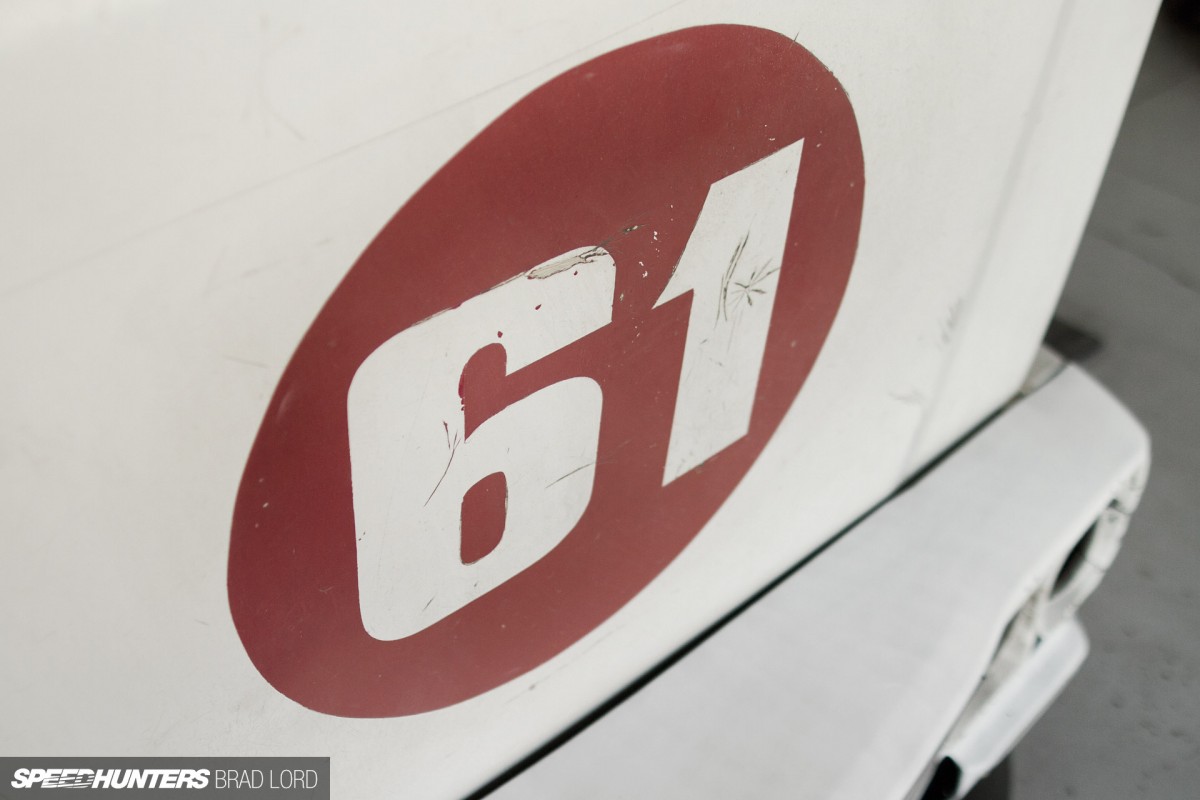
What is found out about its former Japanese life between now and when the restoration begins, will ultimately decide the fate of the Mazda. If the search proves fruitless, it’ll be faithfully restored to the late ’70s IMSA specification that Cosentino ran in race at Daytona, Sebring and Laguna Seca – hand-painted Benihana logo on the roof, #61 rising sun on the bonnet and all. Either way, I cannot wait to see the final result…

As I mentioned earlier, Gavin has all the information about the car when it ran in the US, and right down to telegrams back to Japan and the original 1978 sales receipt. Before then though, it’s all blurry, so any leads that Speedhunters readers might be able to provide would be most appreciated and definitely followed up on. Someone out there must know something…
日本の読者の皆さんの中に、
Brad Lord
brad@speedhunters.com






More of this kind of story would be excellent, so interesting, old race cars are so awesome!
I love cars like this, and throw in a mystery and it's even better. I looked on Google for the hell of it, and came across the attached photo from the '73 Fuji 1000km. I clicked on it to hopefully get a bigger photo, but it looks like it's no longer hosted. It just caught my eye because it's white, red and blue. Forgive me if it's not an RX-3, my limited knowledge of the car and tiny low res photo doesn't help. It also looks like there might be a single bar running up throw the rear window too. Hopefully it's something! If not, it's still fun either way!
Love this story ! inspiring to see resurrections of these beauties. Would like to see more of these as there are many legendary cars left unattended
Definitely an early 1972-73 car, as the steering wheel and twin distributor engine suggest. If the restoration is going back to the early look, it would be nice to save the bonnet, doors, and trunk lid as they are now, and maybe even put them, the later wider flares, and the updated nose cone and taillights onto another shell, to save a bit of the Cosentino IMSA history as well. You have the patterns right there to build a FAZA replica.
Dutch 1960
EricSeanDelaney They are indeed both RX-3s - series one cars with the small flares, as you'd expect for the year. I've seen both those photos before, and thought the exact same thing about the striped car - but it's bit different though from what we can tell. Nice spotting on the single bar though!
@Dutch 1960 Thanks for the comments! You're right; there are a few options for the restoration and they'll largely depend on what can be determined on its previous history. To be honest, I was really surprised to still see the 12A twin dizzy MFR motor still intact... Definitely a nice bonus for the restoration though!
BradLord EricSeanDelaney The white, blue and red car makes sense. The blue and red stripe look like they could wrap around the back of the car, smaller flares.
Excellent story, great piece of preserved history.
i need more infos about rx3 race cars ! i have one racing rx3 in restomode right now and need more infos for a perfectly rebuild!
love those cars!
Wow, amazing article. I love stuff like this. Cars that are this great and shrouded in mystery. Such an interesting read. reminds me of the RS200 that was on here, found covered in dust in a parking garage in Japan. Great article.
This thing is perfect just the way it is.
I fall in love with this story. Once when I was having my Abarth obsession I was browsing through tons and tons of abarth cars pictures. As soon as I saw this mazda I remembered that I have a picture of a similar mazda with FAZA Mazda decal on it, which I though is very strange. Fortunately I still have the picture on my computer and when I opened it I saw the same color scheme, same number, and a text saying: "The 25 hours of Daytona ~ 1978". I could be wrong but I think it is the same car. Feeling soo excited right now....
Where can you get these flares and front airdam?
/Mikael in sweden
A gem has been recovered! I hope more information is found, please tell us if anything else is found. This is pure heritage, to the point where you become a hunter for information. I wish I knew something, other than what I've learned so far. I will ask some of my Japanese friends if the know of any shops or people that go with those names. Hopefully all of the history can be found and recorded for the new owner. Brad, awesome job on the photography and write of this piece of history.
Wow...what a find. I'd love to be on the recieving end of this.
Very good article and hope more is found out. There was a all red RX3 in JTCC in 72. It was a small fender car but that would line up with the pics of the silver one. Have a feeling the fat flares where put on the car after it was brought to the states. I would also think the four link was done once it was here as well. I really hope you have a story coming for the SA22.
My ideal barn find car would a lancia delta s4 stradale, absolutely love anythong from the group B era! Know everything from the group B eera!
Curious whether other JTCC RX3s had the four link and the tall shock towers that intrude into the passenger compartment. Any front negative camber must have been done at the bottom suspension links, as the strut tops look stock.
If you are looking for what driver's seat was in the RX3, go look at what is in the FAZA RX7. I would bet the seat, belts, and fire extinguisher set up were simply moved from the RX3 to the RX7, when the car owner moved his racing program over to the newer car.
Curious what the driveline might be in there. I am going to guess an old time factory close ratio box, and a positraction limited slip that clanks and clunks like a Detroit Locker, again all Mazda vintage racing. It is fortunate that so much of the car has been left as it was, rather than changed around and updated.
that suspension setup is interesting. the 4 link is better looking than then watts link on my FB RX7 which is not centered like that.
Dang this is a true gem of history, i always thought these rocked and would love to own one someday!
keep us posted on the restoration
http://www.racingsportscars.com/photo/1979/Watkins_Glen-1979-07-08-061.jpg
hey i was having a dig and found these couple of photos, the first 2 seems to be a list of different liverys in the 1972 jtcc, and the second one is just a photo i stumbled across that sort of looks like what you decribe the original paint job to be, not sure if they are helpful but never the less, hope you figure it out, its certainly a good looking beast
really looking fwd to seeing what time will reveal.
cant help but feel this story needs to be supplemented with a
video documentary - "Speedhunters Presents: Mystery of the Devil RX3"
kamenkachev seeing that the replica fenders look just like the ones in your picture, complete with headlights... it would make sense for them to base their build off of this version of the car. i didn't like the versions of the car without working headlights. it will be interesting to see which version of the car they build. i didn't like the rx-3 until i read this article like 3 times, and now im really intrigued by this car and build. i can't wait to see them get started
This was one hell of a great read. Definitely piqued my interest and a bit of a suspense. Thank you and I look forward to hearing or reading more details about this awesome piece of history.
kamenkachev Well that's definitely the same car - nice find! This is essentially how the car arrived from Japan, minus the FAZA Mazda signage on the doors. You can also still see the Japanese driver Taku Akaike's name on the roof above the drivers door.. Thanks for sharing!
zackspeed333 The car definitely arrived in the US with the large fender flares because it hadn't actually been sold at that point. The '78 Daytona was a test essentially. I'm leaning towards the four-link being done in Japan – perhaps not when the car raced initially, but later when it received a series two visual upgrade, and the wider wheels, which necessitated tubbing etc..
zackspeed333 @Dutch 1960 I am definitely planning to put together a story on the RX-7 too. This car is believed to be the very first SA22C race car built; having been purchased by Cosentino on the day the model was released in the US in '78, and by the end of the day stripped, motor swapped and fitted with modified Fiat 124 roll cage. Here's a photo of that car racing in IMSA alongside the Mazda works cars, and as it sits now in NZ awaiting restoration..
Brad you're a lucky barsteward... Gavin was speaking about this at one of the JNC meets I dragged my butt along to and golly how I've craved the opportunity to see it. Cheers for the insightful article! Richy.
hi, someone can tell me where to read about the history of the championship thanks JTCC
Brad, the bodywork update was almost certainly done prior to export to the US. The 1974-75 nose piece in the US had larger cut outs for the required large bumpers, and the rear light assemblies in the US, used in 1976, had clear reverse lights and rear reflectors integrated into the assemblies. These are non USDM updated parts on this one.
I'll bet Jim Downing in Atlanta might be able to shed some light on this one. He's as close to a vintage rotary race guru as you will find, with an extensive collection of Camel GT series rx-3's and sa22's as well as a bunch of later model IMSA prototypes.
Hi All,
I've been re-building the history of the early IMSA Rotary Racers and although my spreadsheet is not complete, the early years are. I offer this summary of car #61.
Best.
Jose Franco (Owner IMSA #82 RX7)
1978 Daytona 24 Hrs. / 05-Feb-78
53 / Walt Bohren J.Downing T.Akaike / 11 / RX3 1st Mazda to finish Daytona !!
61 / T.Akaike A.Cosentino / 12 / RX3
1978 Sebring 12 Hrs. / 18-Mar-78
61 / A.Cosentino J.Downing / 11 / RX3
Talladega 6 Hrs. / 02-Apr-78
61 / A.Cosentino J.Downing / 11 RX3
Road Atlanta 100 Mi. / 16-Apr-78
61 / A.Cosentino / 8 / RX3
Lime Rock / 29-May-78
61 / A.Cosentino / 10 / RX3
Dear Brad,
Thanks for such great piece. Reading about these rare finds makes the speed hunters culture the knowledgable bunch that it is. Keep creating great pieces like this.
How people can 'complain' about too many fluff pieces on the site, when the same site gives you access to a feature such as this, defies any sense of logic. Without SH, where else would anyone outside of the current owners circle, ever get such access and info? I'm sure the current caretakers collection itself can provide feature after feature. As mentioned by someone else, this would be a perfect candidate for a mini documentary...ala Magnus Walker's initial one. The car has such a colorful past, it would be a real present to the enthusiast culture around the world. Anywhere online we can follow the restoration?
Oosh. How do we end up with so many cool cars here in NZ. I also know of a genuine JTCC RX2/ Capella here. It has the massive flares and a weird 2 piece front spoiler. Very cool also. Nice article =)
MichaelCapen I certainly will!
KieranSmith Thanks for this, all those liveries are quite interesting..
@Kevin Truong Thanks for your comment – it was a lot of fun putting this story together!
JoseFranco Thanks for this Jose - much appreciated!
O4ABDA I have heard there is one, maybe two JTCC R100s in NZ as well as an ex-Katayama RX-3, but not a Capella. The more the merrier though!
SnoozinRichy Thanks Richy, you better come along when we shoot the 7!
Did anyone notice the other rare car under restoration in this photo set?
The story is fairly accurate in that the car was unused since the mid 80s, Al Cosentino knew his stuff, just had too much I guess, i saw this at his house in 2004, he intended to get it running again but time caught the guy out. Faza was bought by an Australian guy and the mazdas were part of the deal. I guess they were bought in via Australia. There are fantastic detailed accounts of the cars success in some of the Abarth books by the wonderful Al Cosentino, the car is significant in Mazda's racing history. Lucky New Zealand!!
Mazboy Thanks for the comment. Yes, both Mazdas were purchased via FAZA's owner in Australia, but came directly from the US. A huge amount of information and a large number of photographs that Al Consentino took and collated were also included, so I can imagine that his books would have been great!
BradLord Haha, was wondering how long it would take you to prompt.... I guess people were so blown away by the RX they didn't look further!
O4ABDA Tell us more! NZ used to get loads of good cars because it was at the end of the world tour when it came to motor racing, so local guys would buy direct from the teams to save them shipping stuff home. In more recent years it's because you guys are just awesome! Per head NZ has some of the finest car culture I've experienced anywhere in the world!
BradLord zackspeed333That thing is the business
Speedhunters_Bryn BradLord Cosmo!
Speedhunters_Bryn BradLord zackspeed333 Having owned a few FB chassis myself I have to say they are one heck of a machine. Growing up seeing the cars race in IMSA and the Camel series makes this story really hit home. Always wanted a RX3 and almost had a SP version but was not to be I guess.
Another cracking example of why Speedhunters is my favourite media channel for car related stories. Very cool this car is in New Zealand and in some respects preserving it as a time capsule would be cool........I get the desire to restore and use but it wears its history well. Keep the updates coming.
It'll have chromies and graf vinyl all over it soon
wOW! I love reading stories like this! This RX is a gem, and carries so much history. I love all the authenticity, and probably the best thing that happened to it was that it sat in storage all those years, keeping all the original period correct parts... Otherwise it might have just ended up in some junkyard stripped out somewhere after a few more owners, not knowing how important this car was. I would love to see a feature on the Savanna RX7 though (hint, hint)
I've found some pictures from JTCC RX-3's. You've probably seen them all already since they're easy to find but some readers might want to see how they used to look
http://philscarblog.wordpress.com/2009/09/28/rx3-2/
Is this maybe the same car as well?
http://www.racingsportscars.com/photo/1979/Watkins_Glen-1979-07-08-061.jpg
[img]http://www.racingsportscars.com/wm/photo/1979/WM_Watkins_Glen-1979-07-08-061.jpg?dir=photo/1979&img=Watkins_Glen-1979-07-08-061.jpg&txt=%c2%a9%20Jan%20Hettler&wi=&mode=Null/img]
Having seen the suspention setup, I now recall Al stating that he had Abarthized the mazdas, the 7 i never saw and he was still bitter after being ripped off by the guy he shared it with. I should have been a bit pushier when we visited in 2004, this car was under a tarp on his back patio!! I have photos somewhere. I believe Morio was still in touch with Al, i last spoke with Al in 2008 maybe a bit earlier. Its sad that Al never achieved his goal of getting the car back on track, at least in Nz this will be appreciated for what it is.
whats so special about this car, its a beaten up pile of race car ther are thousands of mazdas around. I have heard of people having the 20b turbo in these vehicles. this seems a bit weak and irrelevant to be honest.
Ah with age comes history which becomes more interesting as you become more wise with age.......if you have a torana I am sure you appreciate it's history.....
BBTORANA, Man you shouldn't post if you have no idea what you are on about!!! lol This is a classic JTCC car and very rare. It has nothing to do with it being a ferarri or Jaguar it's to do with a very rare find that only comes around once in a life time and if you read the whole lot which you obviously didn't the new owner is going to completely revamp the car back to it's best. If you know about classic 70-80 sports cars which you don't by the sounds of things it will become a great car from a by gone era and a car that plenty of people will love to see again and remember well so just stick to posting on things you know about and not on things that make you look stupid!!! You Moron
You Moron
bbtorana Stop giving us Torana owners a bad rep mate!
Back in the 1990's we bought one of Al's Fiat 128 race cars - also a factory built car and bought that to New Zealand. Fantastically eccentric guy with a hoard of rare racing tinware stuffed in garages and at his home. His self published books and catalogues were a stream of consciousness experience - at least two - the FAZA 128 -X1/9 race world and the 6th edition FAZA bible feature both the RX3 and RX7. AFAIK from those and the conversations in 1995 he had a major falling out with Jim Downing over the RX7 as well as a melt down with IMSA - he was that kind of guy - the SCCA were another pet hate... 10 years after the events he was still red hot angry.
Great car - great history
@FAZA128:
Yes, if you would like some period photos of the IMSA racing, the Faza Fiat Abarth Lancia Bible 6th edition (I think the 5th edition also had similar photos but worse reproduction), is an interesting scrap book - stream of consciousness indeed. I purchased the books from Al himself, despite the warnings from many people as to his condition. Anyway, Al Cosentino's wife was Japanese and for a while he operated a FAZA concession in Japan for a while. From what I know of Cosentino, he was not an engineering type, and I seriously doubt any major fabrication happened other than garage work. Would love to find out more about the Australian gent who has the rest of the FAZA collection.
I would love to read hand paint the original graphics onto the car if It was restored! Nzgraphicdesign@gmail.com give us a email if you read this!
Is there a build forum or anything i can follow up on this?!
any updates on this restoration
Any news regarding this restoration? I'm really curious about it!